SITXCCS007 Case Study: Customer Service in Commercial Cookery
VerifiedAdded on 2023/06/07

T/A American College / International Institute of Management
RTO Code: 31897
CRICOS Code: 03149K
Assessment Tasks and Instructions
Student Name
Student Number
Course and Code SIT40516 Certificate in Commercial Cookery
Unit(s) of Competency and Code(s) SITXCCS007 Enhance customer service experiences
Stream/Cluster
Trainer/Assessor
Assessment for this Unit of Competency/Cluster Details
Assessment 1 Case Study
Assessment 2 Practical Observation
Assessment 3
Assessment conducted in this instance: Assessment 1 2 3
Reasonable Adjustment
1. Has reasonable adjustment been applied to this assessment?
No No further information required
Yes Complete 2.
2. Provide details for the requirements and provisions for adjustment of assessment:
Student to complete
My assessor has discussed the adjustments with me
I agree to the adjustments applied to this assessment
Signature Date
2nd Assessor to complete
I agree the adjustments applied to this assessment are reasonable
SIT Version 1 PAGE 35 of NUMPAGES 36
©Futura Group 2016
Assessment – 1 – Case Study
Paraphrase This Document

T/A American College / International Institute of Management
RTO Code: 31897
CRICOS Code: 03149K
Name
Signature Date
Assessment Guidelines
What will be assessed
The purpose of this assessment is to assess you underpinning knowledge to complete the tasks outlined in the
elements and performance criteria for this unit of competency and relating to the following aspects:
principles and benefits of enhanced customer service experiences and positive communication
techniques to anticipate customer preferences, needs and expectations throughout the service experience
conflict resolution techniques
methods for enhancing service delivery in response to staff and customer feedback
various extras and add-ons to enhance the customer experience:
o additional destinations
o additional tours or cruises
o cocktails and liqueurs to enhance the dining experience
o coordination services at events and conferences
o entrance to events, festivals and entertainment scheduled during customer stay at destination
o entrance to major attractions at destination
o extra food items
o flight fuel emissions offset fee
o local guiding services
o optional meals and dining experiences
o prepayment of baggage charges
o prepayment of in-flight meals
o pre-travel seat selection
o private car transfers in lieu of regular transportation options
o special offers or packages
o specialised styling for events
o storage for luggage after check-out
o travel insurance
o upgraded accommodation and flights
o wine or boutique beers to match meals ordered
specific industry sector:
o professional service standards and protocols for service industry personnel
o attitudes and attributes expected by the service industries to work with customers
o different customer service needs and expectations
o types of customer loyalty programs
o essential features and use of the customer databases
particular organisation:
o designated response times for providing service and resolving complaints
o customer service policies and procedures
SIT Version 1 PAGE 35 of NUMPAGES 36
©Futura Group 2016
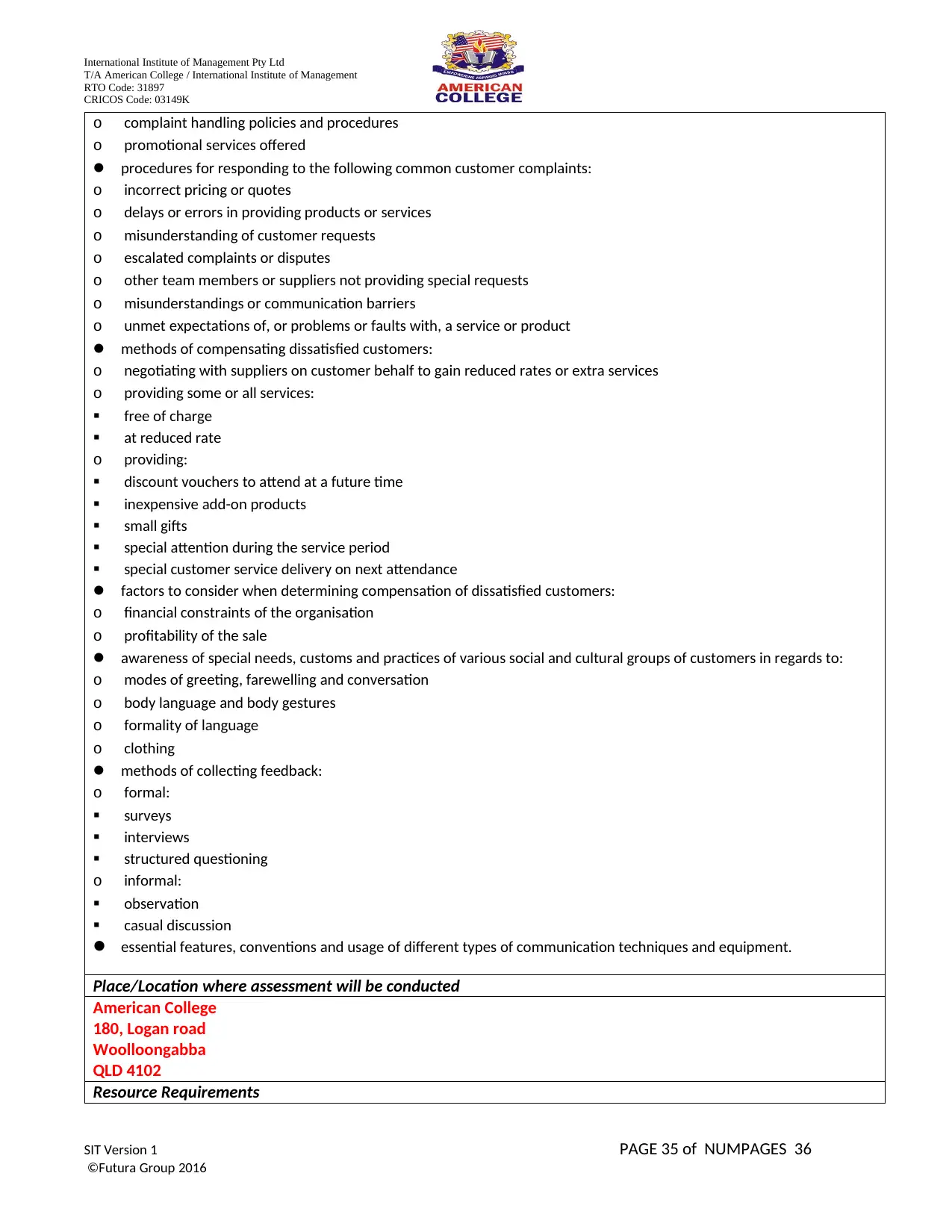
T/A American College / International Institute of Management
RTO Code: 31897
CRICOS Code: 03149K
o complaint handling policies and procedures
o promotional services offered
procedures for responding to the following common customer complaints:
o incorrect pricing or quotes
o delays or errors in providing products or services
o misunderstanding of customer requests
o escalated complaints or disputes
o other team members or suppliers not providing special requests
o misunderstandings or communication barriers
o unmet expectations of, or problems or faults with, a service or product
methods of compensating dissatisfied customers:
o negotiating with suppliers on customer behalf to gain reduced rates or extra services
o providing some or all services:
free of charge
at reduced rate
o providing:
discount vouchers to attend at a future time
inexpensive add-on products
small gifts
special attention during the service period
special customer service delivery on next attendance
factors to consider when determining compensation of dissatisfied customers:
o financial constraints of the organisation
o profitability of the sale
awareness of special needs, customs and practices of various social and cultural groups of customers in regards to:
o modes of greeting, farewelling and conversation
o body language and body gestures
o formality of language
o clothing
methods of collecting feedback:
o formal:
surveys
interviews
structured questioning
o informal:
observation
casual discussion
essential features, conventions and usage of different types of communication techniques and equipment.
Place/Location where assessment will be conducted
American College
180, Logan road
Woolloongabba
QLD 4102
Resource Requirements
SIT Version 1 PAGE 35 of NUMPAGES 36
©Futura Group 2016
⊘ This is a preview!⊘
Do you want full access?
Subscribe today to unlock all pages.

Trusted by 1+ million students worldwide
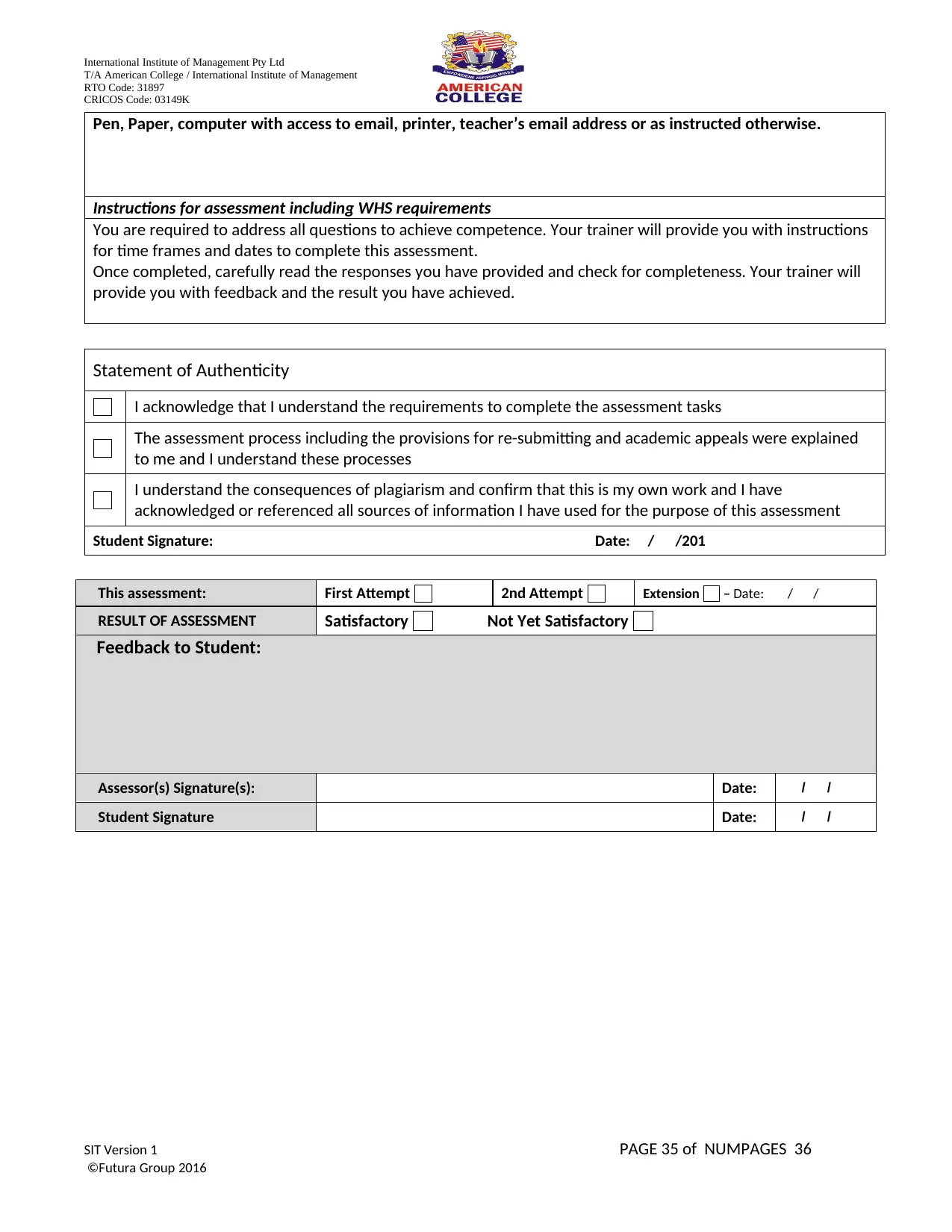
T/A American College / International Institute of Management
RTO Code: 31897
CRICOS Code: 03149K
Pen, Paper, computer with access to email, printer, teacher’s email address or as instructed otherwise.
Instructions for assessment including WHS requirements
You are required to address all questions to achieve competence. Your trainer will provide you with instructions
for time frames and dates to complete this assessment.
Once completed, carefully read the responses you have provided and check for completeness. Your trainer will
provide you with feedback and the result you have achieved.
Statement of Authenticity
I acknowledge that I understand the requirements to complete the assessment tasks
The assessment process including the provisions for re-submitting and academic appeals were explained
to me and I understand these processes
I understand the consequences of plagiarism and confirm that this is my own work and I have
acknowledged or referenced all sources of information I have used for the purpose of this assessment
Student Signature: Date: / /201
This assessment: First Attempt 2nd Attempt Extension – Date: / /
RESULT OF ASSESSMENT Satisfactory Not Yet Satisfactory
Feedback to Student:
Assessor(s) Signature(s): Date: / /
Student Signature Date: / /
SIT Version 1 PAGE 35 of NUMPAGES 36
©Futura Group 2016
Paraphrase This Document
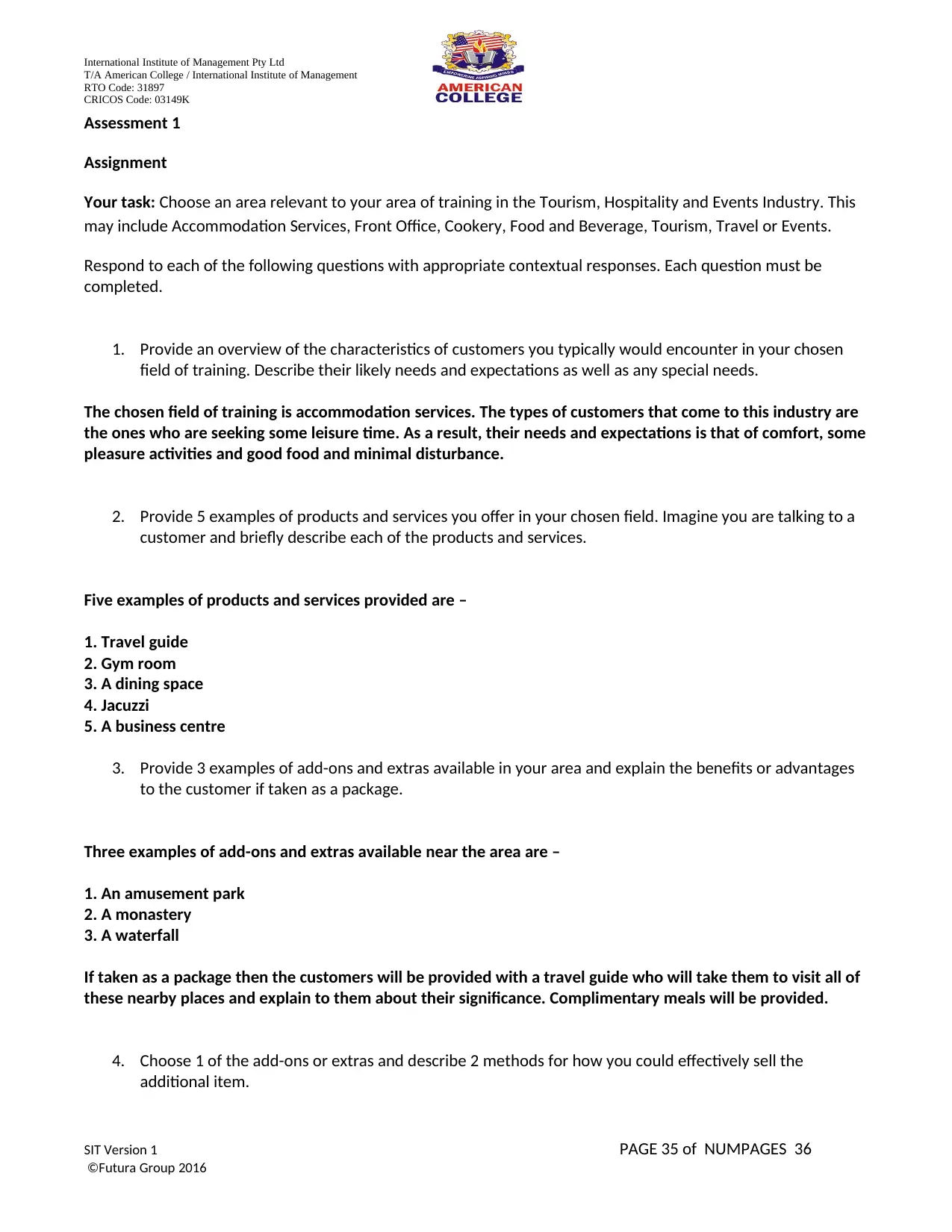
T/A American College / International Institute of Management
RTO Code: 31897
CRICOS Code: 03149K
Assessment 1
Assignment
Your task: Choose an area relevant to your area of training in the Tourism, Hospitality and Events Industry. This
may include Accommodation Services, Front Office, Cookery, Food and Beverage, Tourism, Travel or Events.
Respond to each of the following questions with appropriate contextual responses. Each question must be
completed.
1. Provide an overview of the characteristics of customers you typically would encounter in your chosen
field of training. Describe their likely needs and expectations as well as any special needs.
The chosen field of training is accommodation services. The types of customers that come to this industry are
the ones who are seeking some leisure time. As a result, their needs and expectations is that of comfort, some
pleasure activities and good food and minimal disturbance.
2. Provide 5 examples of products and services you offer in your chosen field. Imagine you are talking to a
customer and briefly describe each of the products and services.
Five examples of products and services provided are –
1. Travel guide
2. Gym room
3. A dining space
4. Jacuzzi
5. A business centre
3. Provide 3 examples of add-ons and extras available in your area and explain the benefits or advantages
to the customer if taken as a package.
Three examples of add-ons and extras available near the area are –
1. An amusement park
2. A monastery
3. A waterfall
If taken as a package then the customers will be provided with a travel guide who will take them to visit all of
these nearby places and explain to them about their significance. Complimentary meals will be provided.
4. Choose 1 of the add-ons or extras and describe 2 methods for how you could effectively sell the
additional item.
SIT Version 1 PAGE 35 of NUMPAGES 36
©Futura Group 2016
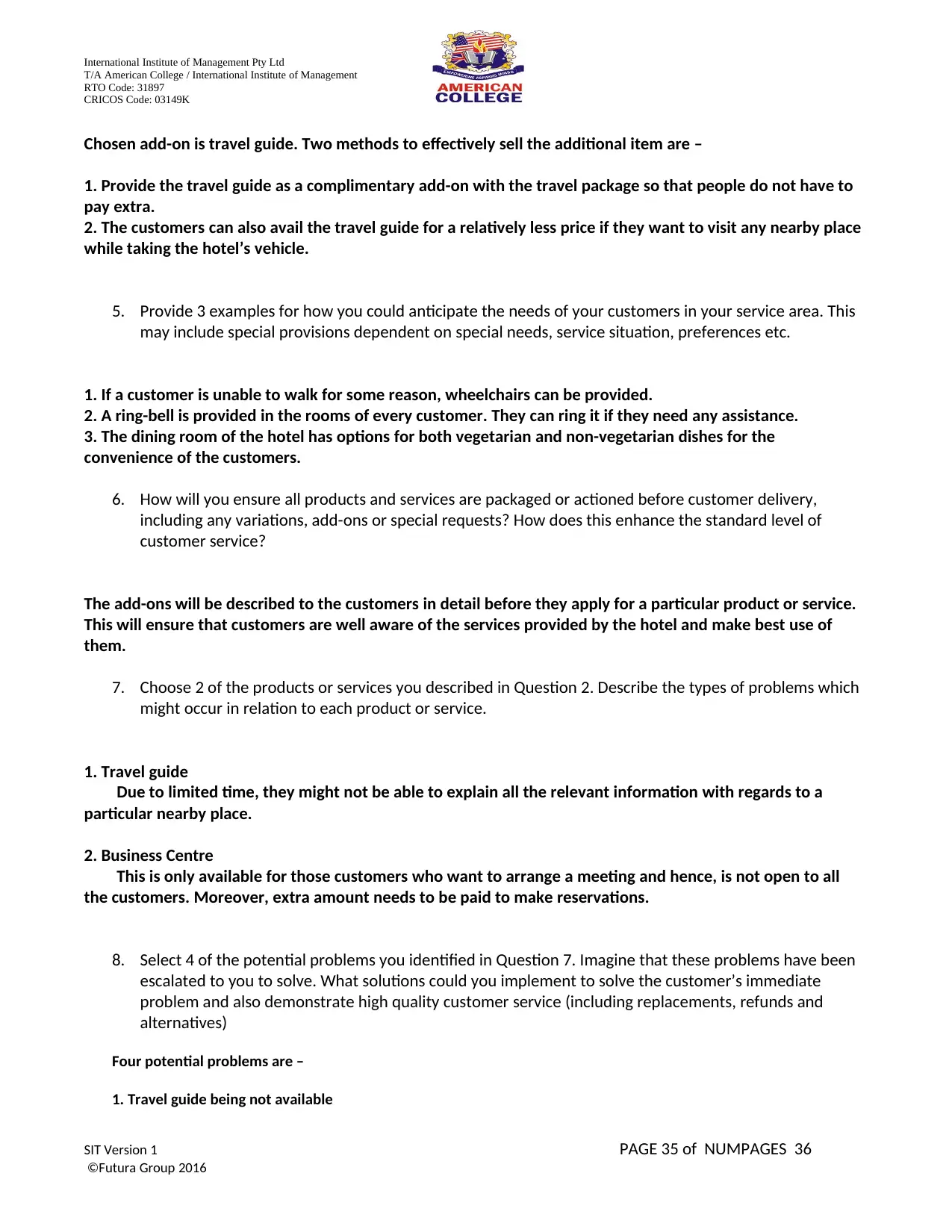
T/A American College / International Institute of Management
RTO Code: 31897
CRICOS Code: 03149K
Chosen add-on is travel guide. Two methods to effectively sell the additional item are –
1. Provide the travel guide as a complimentary add-on with the travel package so that people do not have to
pay extra.
2. The customers can also avail the travel guide for a relatively less price if they want to visit any nearby place
while taking the hotel’s vehicle.
5. Provide 3 examples for how you could anticipate the needs of your customers in your service area. This
may include special provisions dependent on special needs, service situation, preferences etc.
1. If a customer is unable to walk for some reason, wheelchairs can be provided.
2. A ring-bell is provided in the rooms of every customer. They can ring it if they need any assistance.
3. The dining room of the hotel has options for both vegetarian and non-vegetarian dishes for the
convenience of the customers.
6. How will you ensure all products and services are packaged or actioned before customer delivery,
including any variations, add-ons or special requests? How does this enhance the standard level of
customer service?
The add-ons will be described to the customers in detail before they apply for a particular product or service.
This will ensure that customers are well aware of the services provided by the hotel and make best use of
them.
7. Choose 2 of the products or services you described in Question 2. Describe the types of problems which
might occur in relation to each product or service.
1. Travel guide
Due to limited time, they might not be able to explain all the relevant information with regards to a
particular nearby place.
2. Business Centre
This is only available for those customers who want to arrange a meeting and hence, is not open to all
the customers. Moreover, extra amount needs to be paid to make reservations.
8. Select 4 of the potential problems you identified in Question 7. Imagine that these problems have been
escalated to you to solve. What solutions could you implement to solve the customer’s immediate
problem and also demonstrate high quality customer service (including replacements, refunds and
alternatives)
Four potential problems are –
1. Travel guide being not available
SIT Version 1 PAGE 35 of NUMPAGES 36
©Futura Group 2016
⊘ This is a preview!⊘
Do you want full access?
Subscribe today to unlock all pages.

Trusted by 1+ million students worldwide

T/A American College / International Institute of Management
RTO Code: 31897
CRICOS Code: 03149K
In such cases, the customer will be refunded their money
2. The travel guide being unable to complete the day’s itinerary
In such cases, the customers will be given an alternative in the way of another half days’ worth of tour.
3. The business centre being not available for two parties simultaneously
In such cases the second party will be provided a replacement in the form of another room.
4. The business centre being wanted to be used for other purposes than conducting a meeting.
In such cases, the customer will be provided an alternative room to host their event.
9. How would you ensure similar problems could be avoided and service provisions improved in the
future? What would this require and how should this be managed within the team in your service area?
Better guidelines should be provided to the hotel staffs so that they can explain the situation to the customers
efficiently. This requires training for the staff after every six months so that they are kept updated on the
requirements.
10. Explain the procedures for dealing with conflict, outlining the steps and requirements for verbal and non
verbal communication. What are your responsibilities as a supervisor/manager?
In order to deal with conflicts, the first step is the necessity to maintain calm and composure.
As a supervisor, verbally communicating with the customers is a necessity. Their issues and problems should be resolved
in a clear way. Moreover, in the case of non-verbal communication, the supervisor should ensure that the customers face
no problems after the resolution of the conflict.
11. Provide 3 examples of promotional items or initiatives which could be used in your service area, e.g.
loyalty programs, and explain how these would be used effectively.
1. Package system - which includes a visit to the nearby places.
2. Loyalty programs – that is if customers choose the hotel every time they come for a vacation then they will be given
huge discounts along with a complimentary meal during every day of their stay
3. Discounts – If a customer visit the hotel during the off-season, they can book the rooms and avail the additional
services at a discounted price.
12. Develop a customer feedback form which would allow collection of:
a. Details of customers to establish a database
b. Responses to questions enquiring about the product and services you provide in your service
area
c. Additional comments or feedback from customers
d. Special preferences of a customer
CUSTOMER FEEDBACK FORM
Name
SIT Version 1 PAGE 35 of NUMPAGES 36
©Futura Group 2016
Paraphrase This Document

T/A American College / International Institute of Management
RTO Code: 31897
CRICOS Code: 03149K
Age
Gender
Contact Details
How did you like our products and services?
Please provide your feedback regarding any aspect of our hotel
Is there any special preference of yours that needs to be lokked after?
13. Explain how you will evaluate this feedback form, how you would utilise the collected data and how this
would be useful to develop an ongoing customer relationship.
All the details collected in the form will be carefully evaluated and the special preferences of the customers will be
diligently looked in to. Moreover, any complaints they have with the hotel will be immediately resolved and conveyed to
the customer. This will help to improve the customer relationship.
14. List 3 examples for customer with special needs or disabilities you may encounter in your work area.
What are special requirements are likely for the examples you have provided?
1. Need for assistance for old people – Special requirement for wheelchairs or a hotel staff who will look after
the person during the entire duration of the stay.
2. Special needs in terms of food and beverages – The food should be cooked in a separate place by a separate
chef.
3. Need for absolute privacy during the entire duration of the stay – Care should be taken that no room
cleaning service is sent to the individual’s room and he or she is not disturbed at any point of time without
prior approval.
15. List 3 factors which must be considered when you need to compensate a customer to ensure both, the
interest of the business and the customer are satisfied?
1. The compensation given to the customer does not negatively impact the profits of the business.
2. The services and products given in compensation should be of good quality.
3. The customer must be satisfied with the compensation received.
SIT Version 1 PAGE 35 of NUMPAGES 36
©Futura Group 2016

T/A American College / International Institute of Management
RTO Code: 31897
CRICOS Code: 03149K
Assessment Tasks and Instructions
Student Name
Student Number
Course and Code SIT40516 Certificate in Commercial Cookery
Unit(s) of Competency and Code(s) SITXCCS007 Enhance customer service experiences
Stream/Cluster
Trainer/Assessor
Assessment for this Unit of Competency/Cluster Details
Assessment 1 Case study
Assessment 2 Practical observation
Assessment 3
Assessment conducted in this instance: Assessment 1 2 3
Reasonable Adjustment
3. Has reasonable adjustment been applied to this assessment?
No No further information required
Yes Complete 2.
4. Provide details for the requirements and provisions for adjustment of assessment:
Student to complete
My assessor has discussed the adjustments with me
I agree to the adjustments applied to this assessment
Signature Date
SIT Version 1 PAGE 35 of NUMPAGES 36
©Futura Group 2016
Assessment – 2 – Observations
⊘ This is a preview!⊘
Do you want full access?
Subscribe today to unlock all pages.

Trusted by 1+ million students worldwide

T/A American College / International Institute of Management
RTO Code: 31897
CRICOS Code: 03149K
2nd Assessor to complete
I agree the adjustments applied to this assessment are reasonable
Name
Signature Date
Assessment Guidelines
What will be assessed
The purpose of this assessment is to assess your ability to complete tasks outlined in elements and
performance criteria of this unit in the context of the job role, and:
identify customer requirements and provide professional and personalised customer service experiences
to two different internal and two different external customers to meet requirements
demonstrate procedures to respond to and resolve three different customer complaints according to
organisational policies and procedures
demonstrate effective communication with the above internal and external customers, including any with
special needs
seek formal and informal feedback from customers on quality of above service
provide above service to above customers in line with organisational customer service standards and
within designated organisational response times.
Place/Location where assessment will be conducted
American College
180, Logan road
Woolloongabba
QLD 4102
Resource Requirements
Refer to the Assessment conditions attached to the Futura Group Mapping Document located in the teacher
support tools folder or the “Assessment Conditions” for this unit in the SIT 1.0 Training Package.
For this assessment a full set of organisational policies and procedures relevant for the customer service
charter must be provided to the student
Instructions for assessment including WHS requirements
1. You are required to wear a complete uniform applicable to your area of training or as instructed
2. Your personal presentation must reflect the standards typically expected and acceptable in the
hospitality and tourism industry.
SIT Version 1 PAGE 35 of NUMPAGES 36
©Futura Group 2016
Paraphrase This Document

T/A American College / International Institute of Management
RTO Code: 31897
CRICOS Code: 03149K
3. You will be observed completing each of the following tasks set out below.
4. The practical observations for this unit of competency include the following requirements listed for each
task
Part A.
You will be observed demonstrating how you identify customer requirements and provide effective
service to 4 different customers:
1. 2 different internal customers
2. 2 different external customers
Part B.
You will be observed demonstrating how you respond to 3 different customer complaints
according to organisational policies and procedures
The observation criteria below provide a guideline for criteria relevant for each task.
Statement of Authenticity
I acknowledge that I understand the requirements to complete the assessment tasks
The assessment process including the provisions for re-submitting and academic appeals were explained
to me and I understand these processes
I understand the consequences of plagiarism and confirm that this is my own work and I have
acknowledged or referenced all sources of information I have used for the purpose of this assessment
Student Signature: Date: / /201
This assessment: First Attempt 2nd Attempt 3nd Attempt Extension – Date: / /
RESULT OF
ASSESSMENT
Part A
Part B
Satisfactory Not Yet Satisfactory
Satisfactory Not Yet Satisfactory
Feedback to Student:
Assessor(s)
Signature(s): Date: / /
Student Signature Date: / /
SIT Version 1 PAGE 35 of NUMPAGES 36
©Futura Group 2016
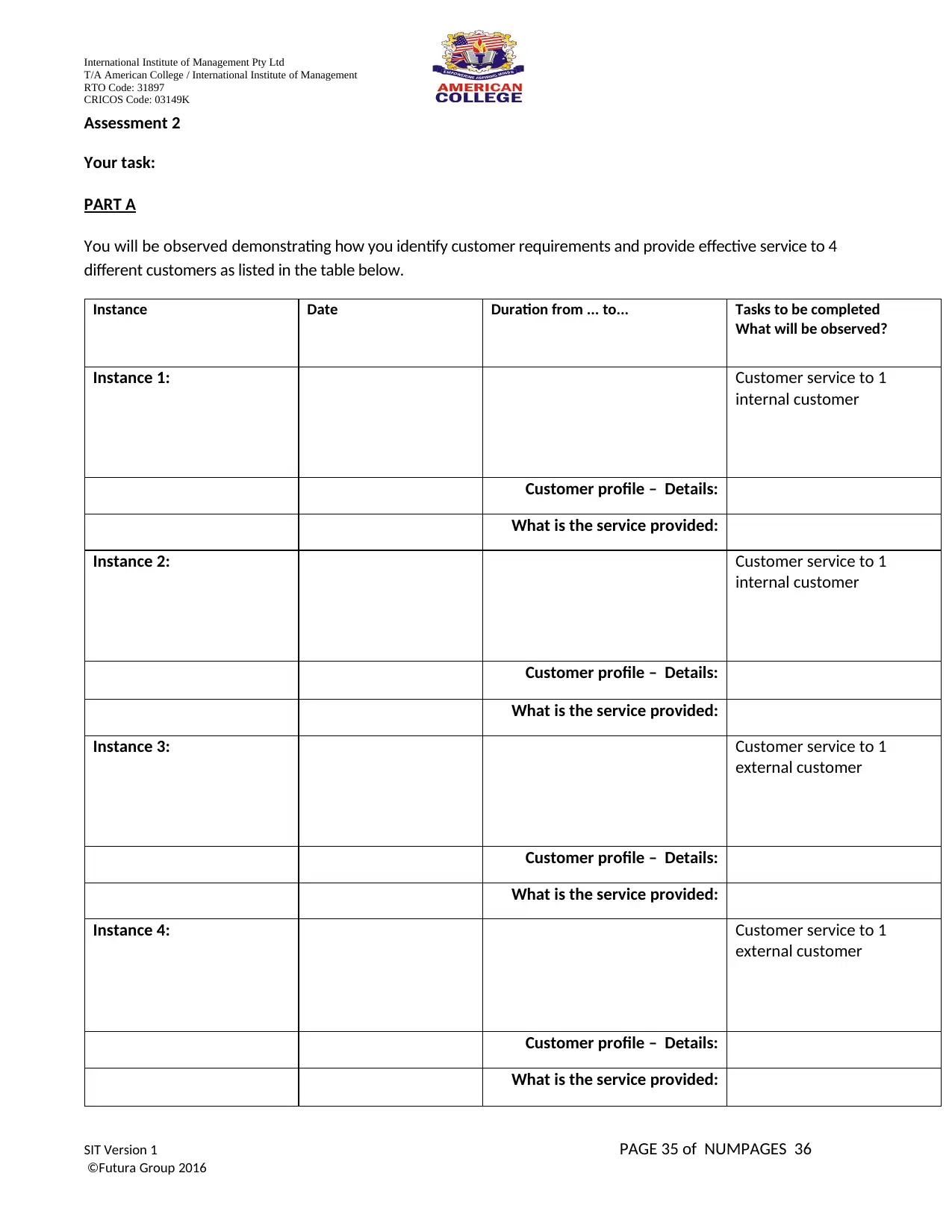
T/A American College / International Institute of Management
RTO Code: 31897
CRICOS Code: 03149K
Assessment 2
Your task:
PART A
You will be observed demonstrating how you identify customer requirements and provide effective service to 4
different customers as listed in the table below.
Instance Date Duration from ... to... Tasks to be completed
What will be observed?
Instance 1: Customer service to 1
internal customer
Customer profile – Details:
What is the service provided:
Instance 2: Customer service to 1
internal customer
Customer profile – Details:
What is the service provided:
Instance 3: Customer service to 1
external customer
Customer profile – Details:
What is the service provided:
Instance 4: Customer service to 1
external customer
Customer profile – Details:
What is the service provided:
SIT Version 1 PAGE 35 of NUMPAGES 36
©Futura Group 2016
⊘ This is a preview!⊘
Do you want full access?
Subscribe today to unlock all pages.

Trusted by 1+ million students worldwide
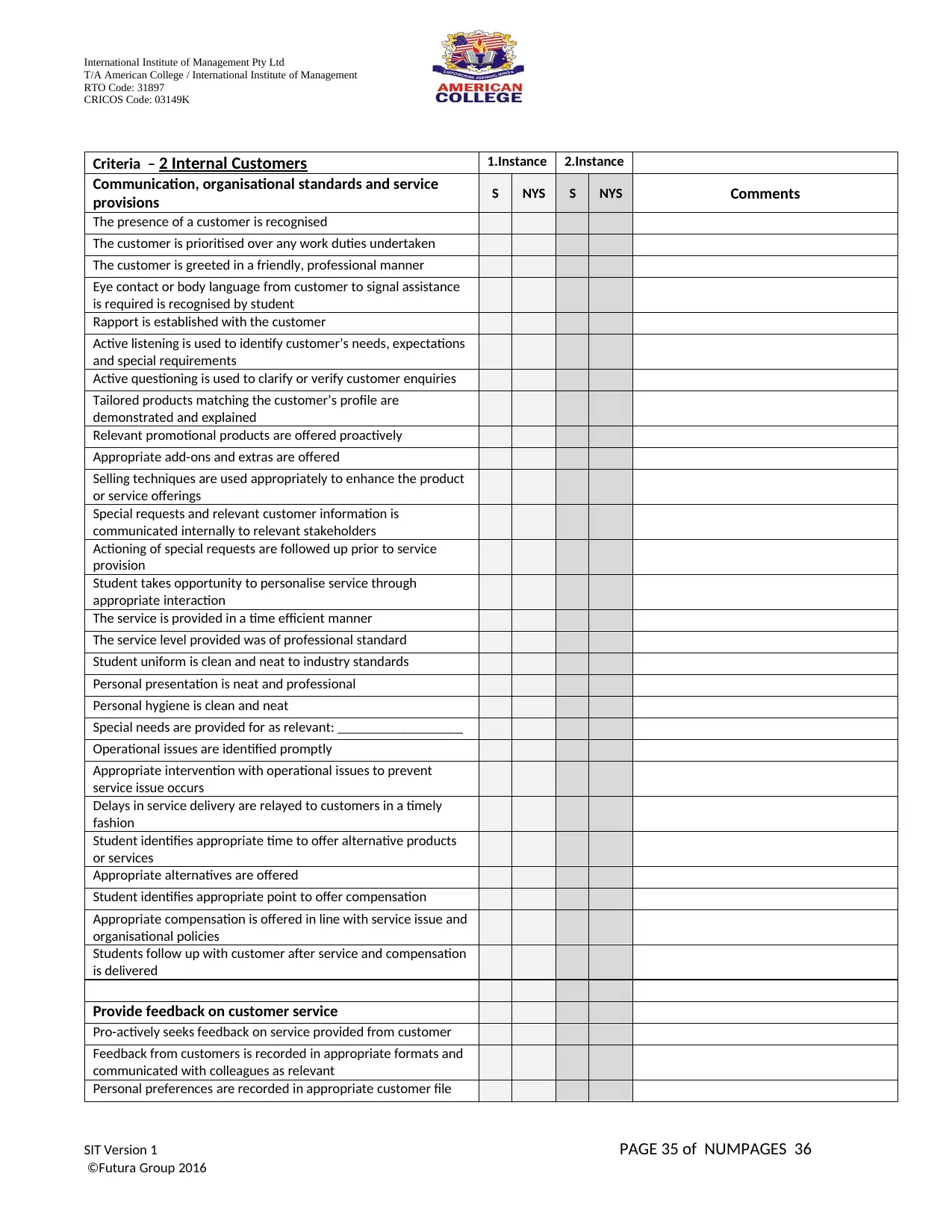
T/A American College / International Institute of Management
RTO Code: 31897
CRICOS Code: 03149K
Criteria – 2 Internal Customers 1.Instance 2.Instance
Communication, organisational standards and service
provisions S NYS S NYS Comments
The presence of a customer is recognised
The customer is prioritised over any work duties undertaken
The customer is greeted in a friendly, professional manner
Eye contact or body language from customer to signal assistance
is required is recognised by student
Rapport is established with the customer
Active listening is used to identify customer’s needs, expectations
and special requirements
Active questioning is used to clarify or verify customer enquiries
Tailored products matching the customer’s profile are
demonstrated and explained
Relevant promotional products are offered proactively
Appropriate add-ons and extras are offered
Selling techniques are used appropriately to enhance the product
or service offerings
Special requests and relevant customer information is
communicated internally to relevant stakeholders
Actioning of special requests are followed up prior to service
provision
Student takes opportunity to personalise service through
appropriate interaction
The service is provided in a time efficient manner
The service level provided was of professional standard
Student uniform is clean and neat to industry standards
Personal presentation is neat and professional
Personal hygiene is clean and neat
Special needs are provided for as relevant: __________________
Operational issues are identified promptly
Appropriate intervention with operational issues to prevent
service issue occurs
Delays in service delivery are relayed to customers in a timely
fashion
Student identifies appropriate time to offer alternative products
or services
Appropriate alternatives are offered
Student identifies appropriate point to offer compensation
Appropriate compensation is offered in line with service issue and
organisational policies
Students follow up with customer after service and compensation
is delivered
Provide feedback on customer service
Pro-actively seeks feedback on service provided from customer
Feedback from customers is recorded in appropriate formats and
communicated with colleagues as relevant
Personal preferences are recorded in appropriate customer file
SIT Version 1 PAGE 35 of NUMPAGES 36
©Futura Group 2016
Paraphrase This Document
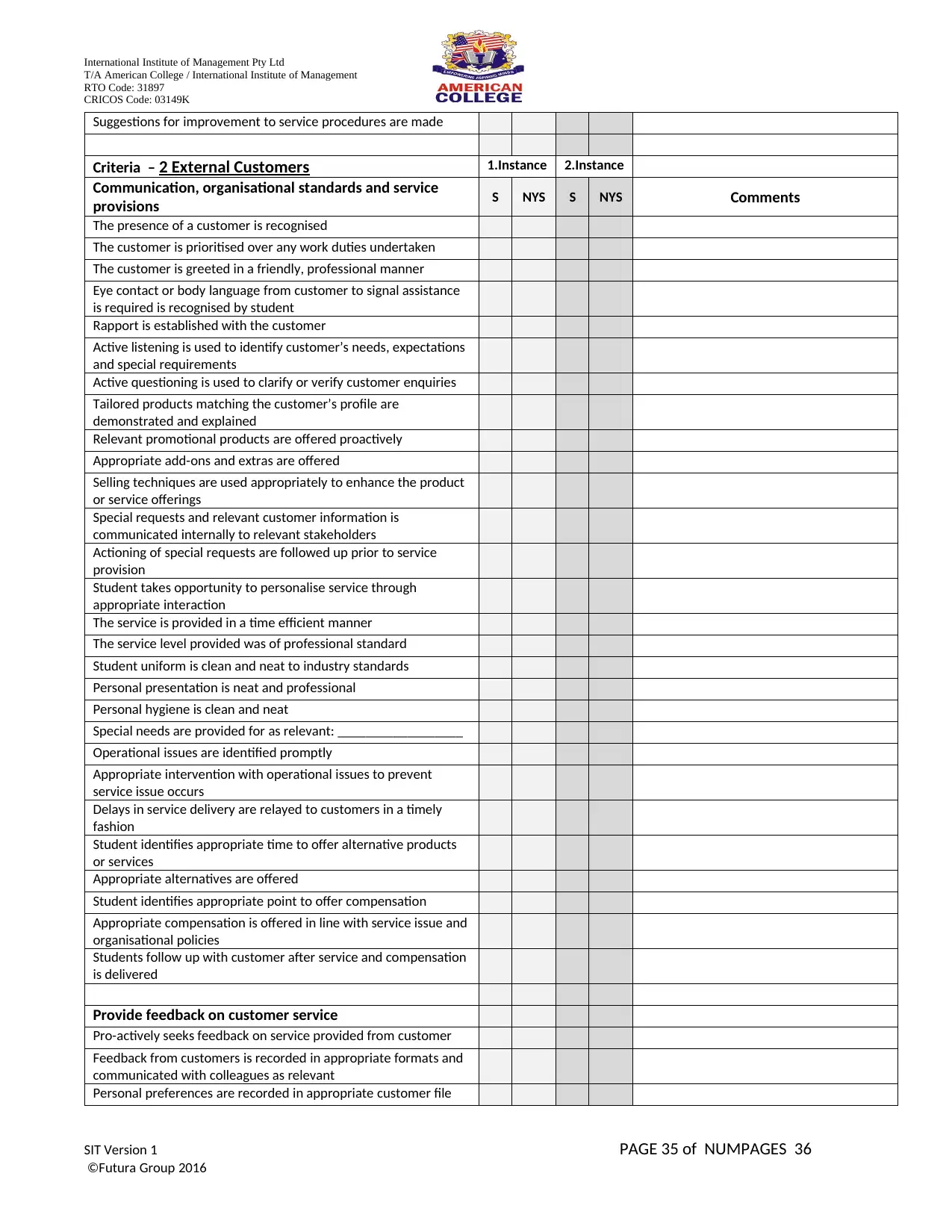
T/A American College / International Institute of Management
RTO Code: 31897
CRICOS Code: 03149K
Suggestions for improvement to service procedures are made
Criteria – 2 External Customers 1.Instance 2.Instance
Communication, organisational standards and service
provisions S NYS S NYS Comments
The presence of a customer is recognised
The customer is prioritised over any work duties undertaken
The customer is greeted in a friendly, professional manner
Eye contact or body language from customer to signal assistance
is required is recognised by student
Rapport is established with the customer
Active listening is used to identify customer’s needs, expectations
and special requirements
Active questioning is used to clarify or verify customer enquiries
Tailored products matching the customer’s profile are
demonstrated and explained
Relevant promotional products are offered proactively
Appropriate add-ons and extras are offered
Selling techniques are used appropriately to enhance the product
or service offerings
Special requests and relevant customer information is
communicated internally to relevant stakeholders
Actioning of special requests are followed up prior to service
provision
Student takes opportunity to personalise service through
appropriate interaction
The service is provided in a time efficient manner
The service level provided was of professional standard
Student uniform is clean and neat to industry standards
Personal presentation is neat and professional
Personal hygiene is clean and neat
Special needs are provided for as relevant: __________________
Operational issues are identified promptly
Appropriate intervention with operational issues to prevent
service issue occurs
Delays in service delivery are relayed to customers in a timely
fashion
Student identifies appropriate time to offer alternative products
or services
Appropriate alternatives are offered
Student identifies appropriate point to offer compensation
Appropriate compensation is offered in line with service issue and
organisational policies
Students follow up with customer after service and compensation
is delivered
Provide feedback on customer service
Pro-actively seeks feedback on service provided from customer
Feedback from customers is recorded in appropriate formats and
communicated with colleagues as relevant
Personal preferences are recorded in appropriate customer file
SIT Version 1 PAGE 35 of NUMPAGES 36
©Futura Group 2016
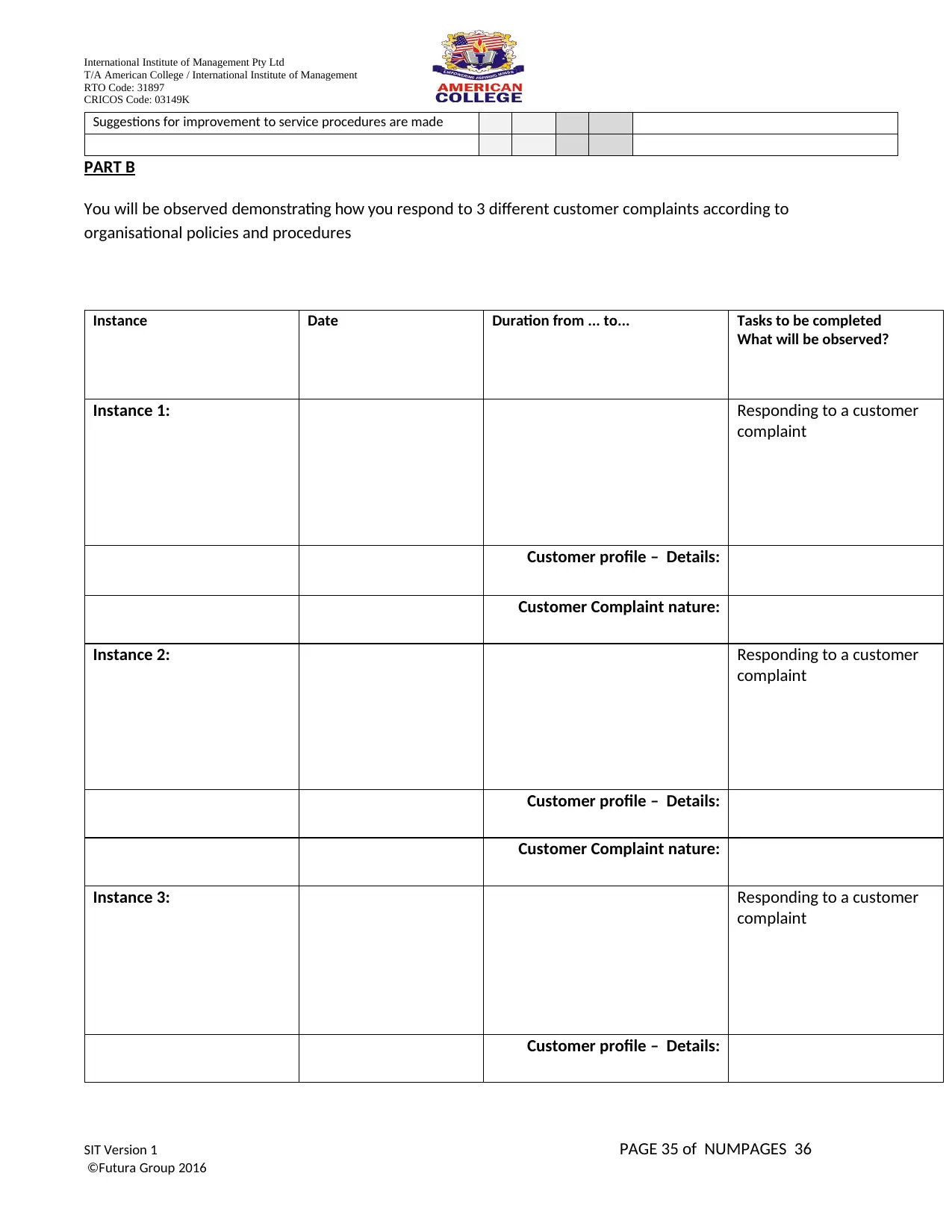
T/A American College / International Institute of Management
RTO Code: 31897
CRICOS Code: 03149K
Suggestions for improvement to service procedures are made
PART B
You will be observed demonstrating how you respond to 3 different customer complaints according to
organisational policies and procedures
Instance Date Duration from ... to... Tasks to be completed
What will be observed?
Instance 1: Responding to a customer
complaint
Customer profile – Details:
Customer Complaint nature:
Instance 2: Responding to a customer
complaint
Customer profile – Details:
Customer Complaint nature:
Instance 3: Responding to a customer
complaint
Customer profile – Details:
SIT Version 1 PAGE 35 of NUMPAGES 36
©Futura Group 2016
⊘ This is a preview!⊘
Do you want full access?
Subscribe today to unlock all pages.

Trusted by 1+ million students worldwide
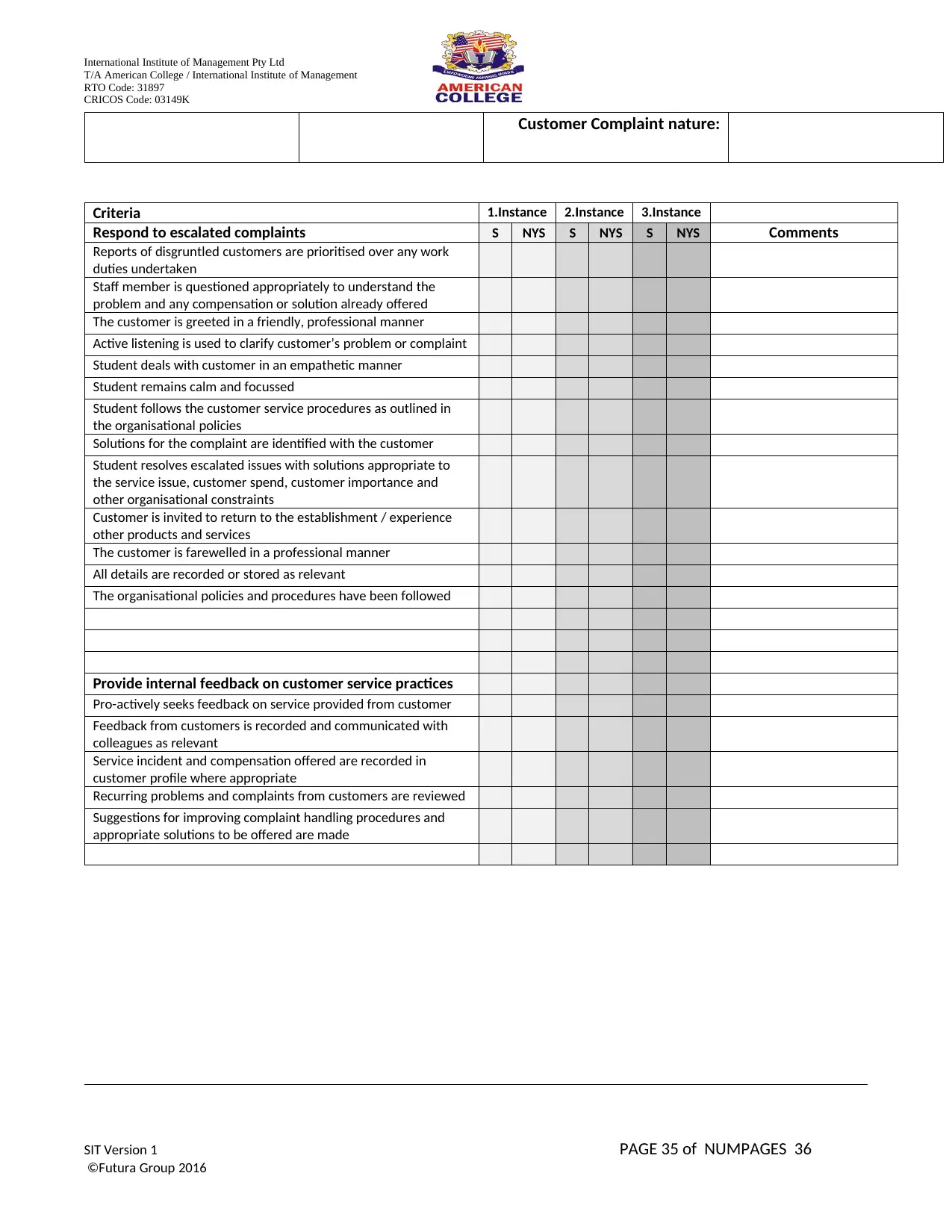
T/A American College / International Institute of Management
RTO Code: 31897
CRICOS Code: 03149K
Customer Complaint nature:
Criteria 1.Instance 2.Instance 3.Instance
Respond to escalated complaints S NYS S NYS S NYS Comments
Reports of disgruntled customers are prioritised over any work
duties undertaken
Staff member is questioned appropriately to understand the
problem and any compensation or solution already offered
The customer is greeted in a friendly, professional manner
Active listening is used to clarify customer’s problem or complaint
Student deals with customer in an empathetic manner
Student remains calm and focussed
Student follows the customer service procedures as outlined in
the organisational policies
Solutions for the complaint are identified with the customer
Student resolves escalated issues with solutions appropriate to
the service issue, customer spend, customer importance and
other organisational constraints
Customer is invited to return to the establishment / experience
other products and services
The customer is farewelled in a professional manner
All details are recorded or stored as relevant
The organisational policies and procedures have been followed
Provide internal feedback on customer service practices
Pro-actively seeks feedback on service provided from customer
Feedback from customers is recorded and communicated with
colleagues as relevant
Service incident and compensation offered are recorded in
customer profile where appropriate
Recurring problems and complaints from customers are reviewed
Suggestions for improving complaint handling procedures and
appropriate solutions to be offered are made
SIT Version 1 PAGE 35 of NUMPAGES 36
©Futura Group 2016
Paraphrase This Document
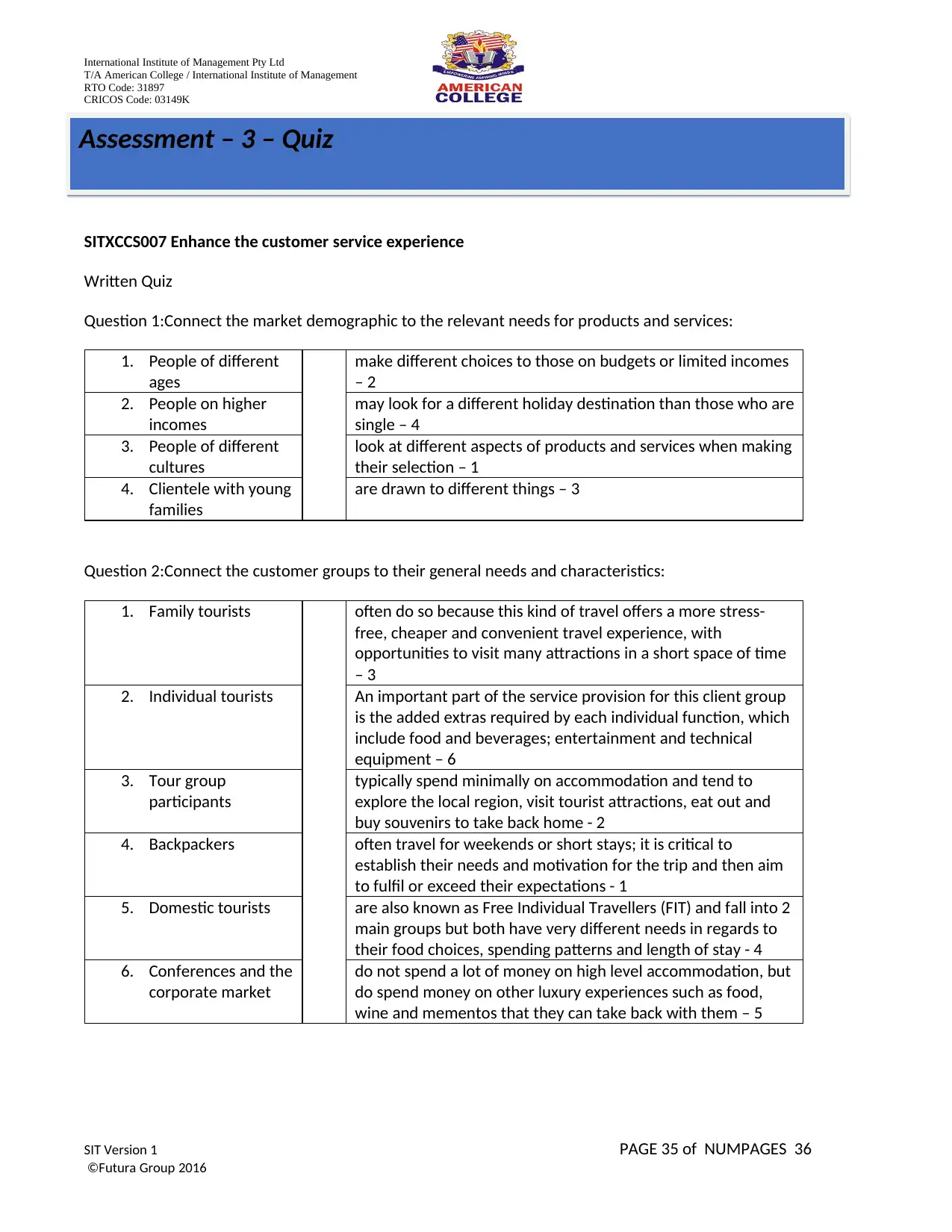
T/A American College / International Institute of Management
RTO Code: 31897
CRICOS Code: 03149K
SITXCCS007 Enhance the customer service experience
Written Quiz
Question 1:Connect the market demographic to the relevant needs for products and services:
1. People of different
ages
make different choices to those on budgets or limited incomes
– 2
2. People on higher
incomes
may look for a different holiday destination than those who are
single – 4
3. People of different
cultures
look at different aspects of products and services when making
their selection – 1
4. Clientele with young
families
are drawn to different things – 3
Question 2:Connect the customer groups to their general needs and characteristics:
1. Family tourists often do so because this kind of travel offers a more stress-
free, cheaper and convenient travel experience, with
opportunities to visit many attractions in a short space of time
– 3
2. Individual tourists An important part of the service provision for this client group
is the added extras required by each individual function, which
include food and beverages; entertainment and technical
equipment – 6
3. Tour group
participants
typically spend minimally on accommodation and tend to
explore the local region, visit tourist attractions, eat out and
buy souvenirs to take back home - 2
4. Backpackers often travel for weekends or short stays; it is critical to
establish their needs and motivation for the trip and then aim
to fulfil or exceed their expectations - 1
5. Domestic tourists are also known as Free Individual Travellers (FIT) and fall into 2
main groups but both have very different needs in regards to
their food choices, spending patterns and length of stay - 4
6. Conferences and the
corporate market
do not spend a lot of money on high level accommodation, but
do spend money on other luxury experiences such as food,
wine and mementos that they can take back with them – 5
SIT Version 1 PAGE 35 of NUMPAGES 36
©Futura Group 2016
Assessment – 3 – Quiz

T/A American College / International Institute of Management
RTO Code: 31897
CRICOS Code: 03149K
Question 3:In order to determine whether we meet customer needs and expectations, we should bear in mind
how we would be satisfied with the level of products and service we provide by asking ourselves the following
questions:
(Tick the correct answers)
As the customer, what would be my needs and expectations?
As the customer, would I have expected a product free of charge?
Was I made to feel special?
Which proportion of the price pays for the brand name?
Did I receive a desired or preferred standard of service?
/Question 4:
Internal customers could include the following individuals:
(Tick the correct answers)
Colleagues
Supervisors
Managers
Team members
Tourists
Conference delegates
Staff from other departments, branches or locations
Question 5:Common service standards that should be upheld in the Tourism, Hospitality and Events industry
include:
(Tick the correct box indicating true or false)
True False
Providing timely service
Being willing to help
Understanding customer needs
Listening to customers
Providing honest information
Providing security
SIT Version 1 PAGE 35 of NUMPAGES 36
©Futura Group 2016
⊘ This is a preview!⊘
Do you want full access?
Subscribe today to unlock all pages.

Trusted by 1+ million students worldwide
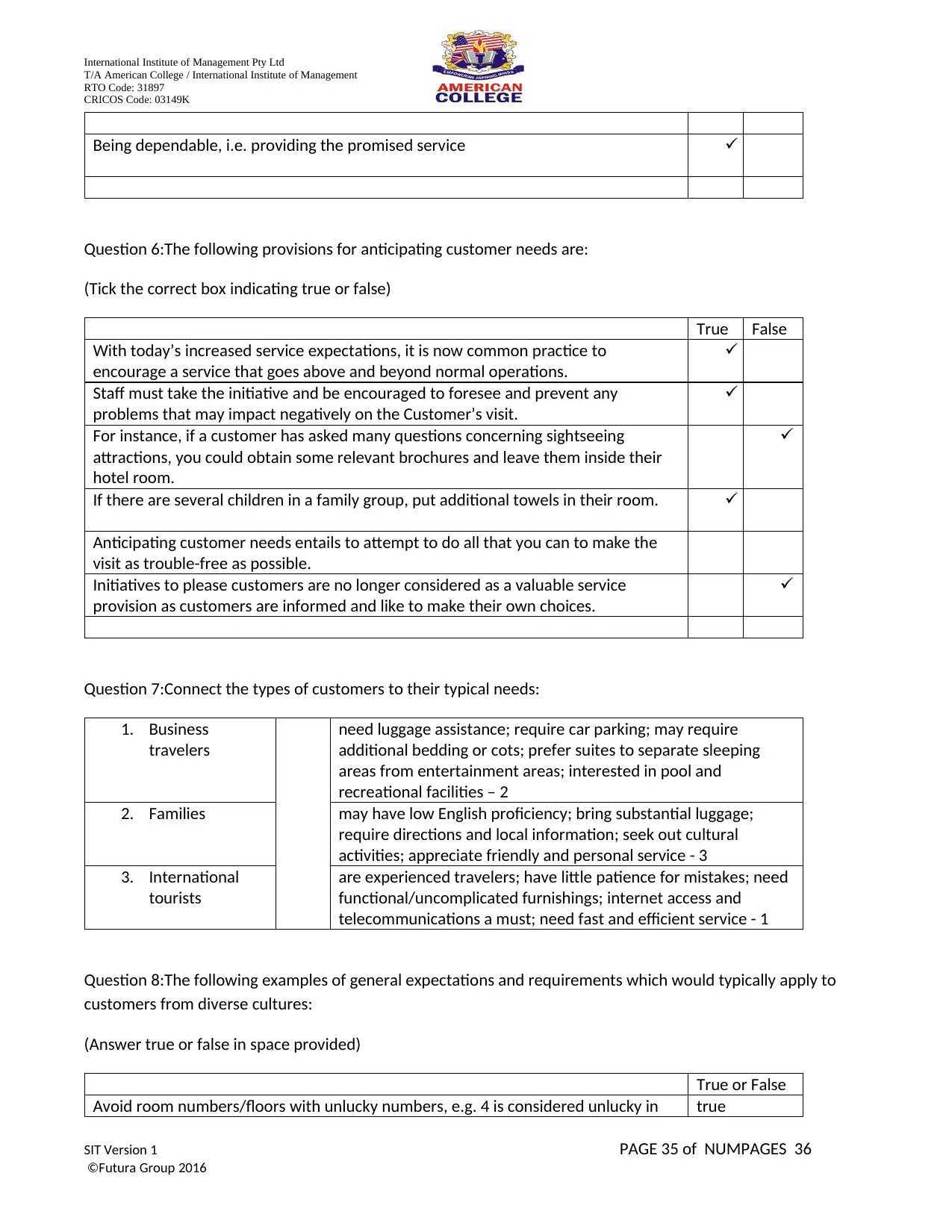
T/A American College / International Institute of Management
RTO Code: 31897
CRICOS Code: 03149K
Being dependable, i.e. providing the promised service
Question 6:The following provisions for anticipating customer needs are:
(Tick the correct box indicating true or false)
True False
With today’s increased service expectations, it is now common practice to
encourage a service that goes above and beyond normal operations.
Staff must take the initiative and be encouraged to foresee and prevent any
problems that may impact negatively on the Customer’s visit.
For instance, if a customer has asked many questions concerning sightseeing
attractions, you could obtain some relevant brochures and leave them inside their
hotel room.
If there are several children in a family group, put additional towels in their room.
Anticipating customer needs entails to attempt to do all that you can to make the
visit as trouble-free as possible.
Initiatives to please customers are no longer considered as a valuable service
provision as customers are informed and like to make their own choices.
Question 7:Connect the types of customers to their typical needs:
1. Business
travelers
need luggage assistance; require car parking; may require
additional bedding or cots; prefer suites to separate sleeping
areas from entertainment areas; interested in pool and
recreational facilities – 2
2. Families may have low English proficiency; bring substantial luggage;
require directions and local information; seek out cultural
activities; appreciate friendly and personal service - 3
3. International
tourists
are experienced travelers; have little patience for mistakes; need
functional/uncomplicated furnishings; internet access and
telecommunications a must; need fast and efficient service - 1
Question 8:The following examples of general expectations and requirements which would typically apply to
customers from diverse cultures:
(Answer true or false in space provided)
True or False
Avoid room numbers/floors with unlucky numbers, e.g. 4 is considered unlucky in true
SIT Version 1 PAGE 35 of NUMPAGES 36
©Futura Group 2016
Paraphrase This Document

T/A American College / International Institute of Management
RTO Code: 31897
CRICOS Code: 03149K
some Asian cultures and some hotels don’t have a 13th floor.
Avoid certain foods, e.g. Muslims and Jews do not eat pork. true
Take offence if spoken to formally and respectfully. false
Expect certain protocols to be followed. true
Be quite demanding and expect a high standard of personalised service (with large
numbers of staff).
True
Question 9:Connect the sales technique to the correct description:
1. Upselling is a technique whereby prices are quoted starting at a high price
and moving down to cheaper options. Particularly if a customer
would advise that it is more than what they wanted to spend - 2
2. Downselling refers to an offer from your product range that you sell to an
existing customer. For example you would cross-sell a holiday
package to an existing corporate client – 3
3. Cross-selling gives you the chance to recommend options that the customer
had not originally considered. The idea behind suggestive selling is
to arouse interest in the customer- 4
4. Suggestive
selling
This practice often uses the technique of starting from the
cheapest price and moving to more expensive options until the
customer selects the level which appeals to them - 1
Question 10:Examples of additional Extras and Add-ons in the TH&E industry commonly would include:
(Tick the correct answers)
Extra destinations in a travel package
Tickets to local events and attractions
Pre-dinner drinks
Side dishes to share
Special dietary requests
Matching wines and beers to menus
Airport transfers and other transportation
Breakfast inclusions
Question 11:
Connect the techniques for making a sale to the relevant description:
1. The alternative
close or
preference
close
involves letting the customer make a smaller decision that
commits them to a bigger decision. It can be combined with the
alternative close approach with good effect – 3
2. The summative involves providing the customer with 2 choices. People do not like
SIT Version 1 PAGE 35 of NUMPAGES 36
©Futura Group 2016
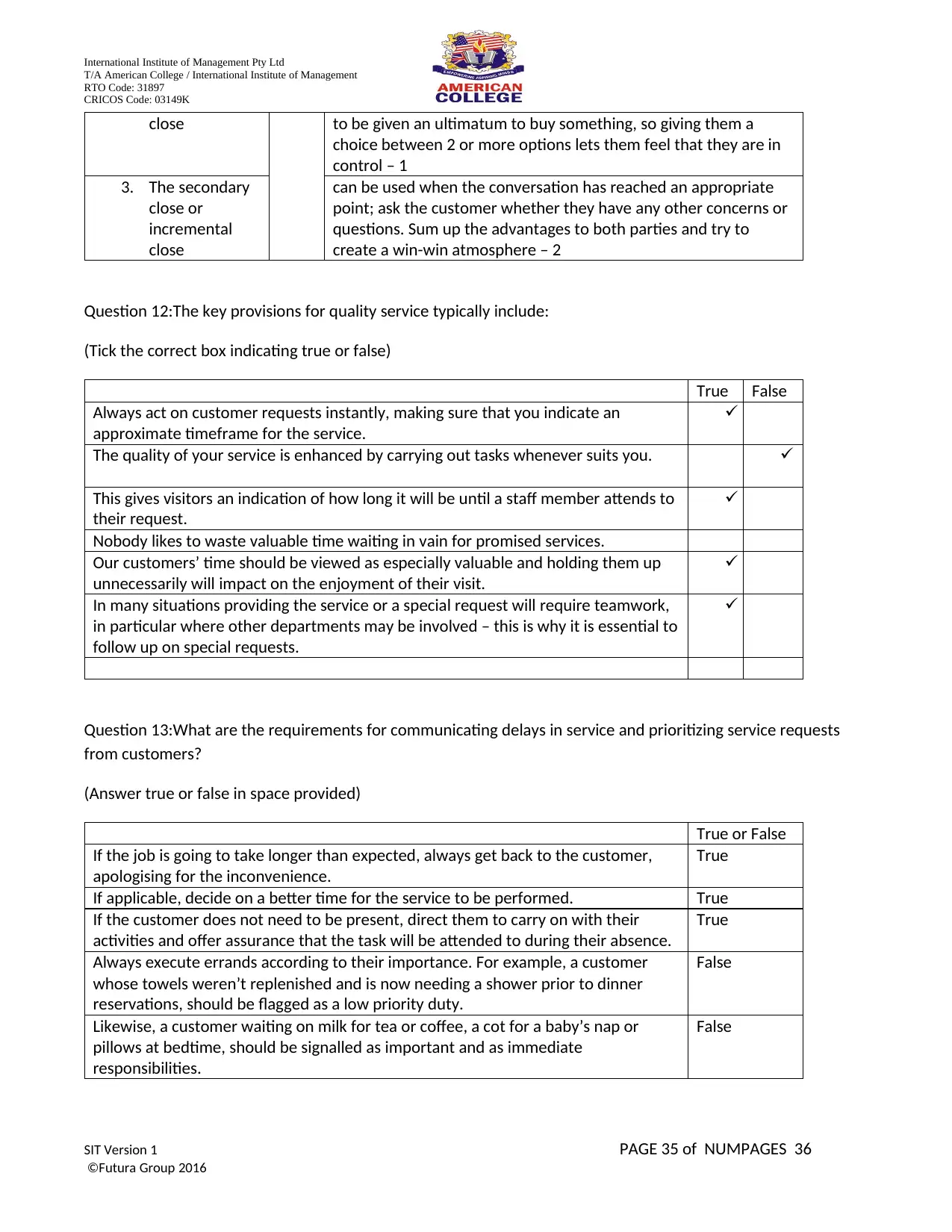
T/A American College / International Institute of Management
RTO Code: 31897
CRICOS Code: 03149K
close to be given an ultimatum to buy something, so giving them a
choice between 2 or more options lets them feel that they are in
control – 1
3. The secondary
close or
incremental
close
can be used when the conversation has reached an appropriate
point; ask the customer whether they have any other concerns or
questions. Sum up the advantages to both parties and try to
create a win-win atmosphere – 2
Question 12:The key provisions for quality service typically include:
(Tick the correct box indicating true or false)
True False
Always act on customer requests instantly, making sure that you indicate an
approximate timeframe for the service.
The quality of your service is enhanced by carrying out tasks whenever suits you.
This gives visitors an indication of how long it will be until a staff member attends to
their request.
Nobody likes to waste valuable time waiting in vain for promised services.
Our customers’ time should be viewed as especially valuable and holding them up
unnecessarily will impact on the enjoyment of their visit.
In many situations providing the service or a special request will require teamwork,
in particular where other departments may be involved – this is why it is essential to
follow up on special requests.
Question 13:What are the requirements for communicating delays in service and prioritizing service requests
from customers?
(Answer true or false in space provided)
True or False
If the job is going to take longer than expected, always get back to the customer,
apologising for the inconvenience.
True
If applicable, decide on a better time for the service to be performed. True
If the customer does not need to be present, direct them to carry on with their
activities and offer assurance that the task will be attended to during their absence.
True
Always execute errands according to their importance. For example, a customer
whose towels weren’t replenished and is now needing a shower prior to dinner
reservations, should be flagged as a low priority duty.
False
Likewise, a customer waiting on milk for tea or coffee, a cot for a baby’s nap or
pillows at bedtime, should be signalled as important and as immediate
responsibilities.
False
SIT Version 1 PAGE 35 of NUMPAGES 36
©Futura Group 2016
⊘ This is a preview!⊘
Do you want full access?
Subscribe today to unlock all pages.

Trusted by 1+ million students worldwide
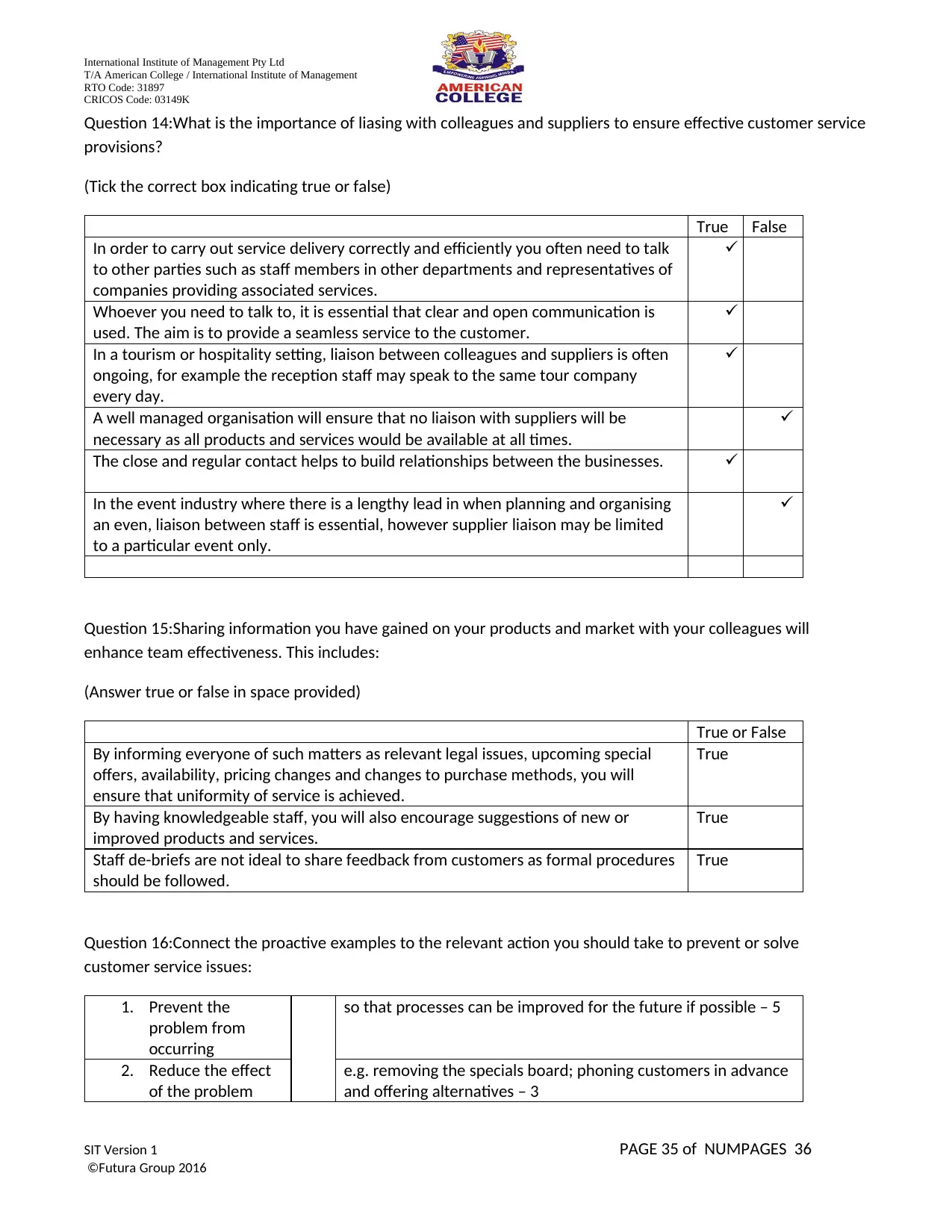
T/A American College / International Institute of Management
RTO Code: 31897
CRICOS Code: 03149K
Question 14:What is the importance of liasing with colleagues and suppliers to ensure effective customer service
provisions?
(Tick the correct box indicating true or false)
True False
In order to carry out service delivery correctly and efficiently you often need to talk
to other parties such as staff members in other departments and representatives of
companies providing associated services.
Whoever you need to talk to, it is essential that clear and open communication is
used. The aim is to provide a seamless service to the customer.
In a tourism or hospitality setting, liaison between colleagues and suppliers is often
ongoing, for example the reception staff may speak to the same tour company
every day.
A well managed organisation will ensure that no liaison with suppliers will be
necessary as all products and services would be available at all times.
The close and regular contact helps to build relationships between the businesses.
In the event industry where there is a lengthy lead in when planning and organising
an even, liaison between staff is essential, however supplier liaison may be limited
to a particular event only.
Question 15:Sharing information you have gained on your products and market with your colleagues will
enhance team effectiveness. This includes:
(Answer true or false in space provided)
True or False
By informing everyone of such matters as relevant legal issues, upcoming special
offers, availability, pricing changes and changes to purchase methods, you will
ensure that uniformity of service is achieved.
True
By having knowledgeable staff, you will also encourage suggestions of new or
improved products and services.
True
Staff de-briefs are not ideal to share feedback from customers as formal procedures
should be followed.
True
Question 16:Connect the proactive examples to the relevant action you should take to prevent or solve
customer service issues:
1. Prevent the
problem from
occurring
so that processes can be improved for the future if possible – 5
2. Reduce the effect
of the problem
e.g. removing the specials board; phoning customers in advance
and offering alternatives – 3
SIT Version 1 PAGE 35 of NUMPAGES 36
©Futura Group 2016
Paraphrase This Document
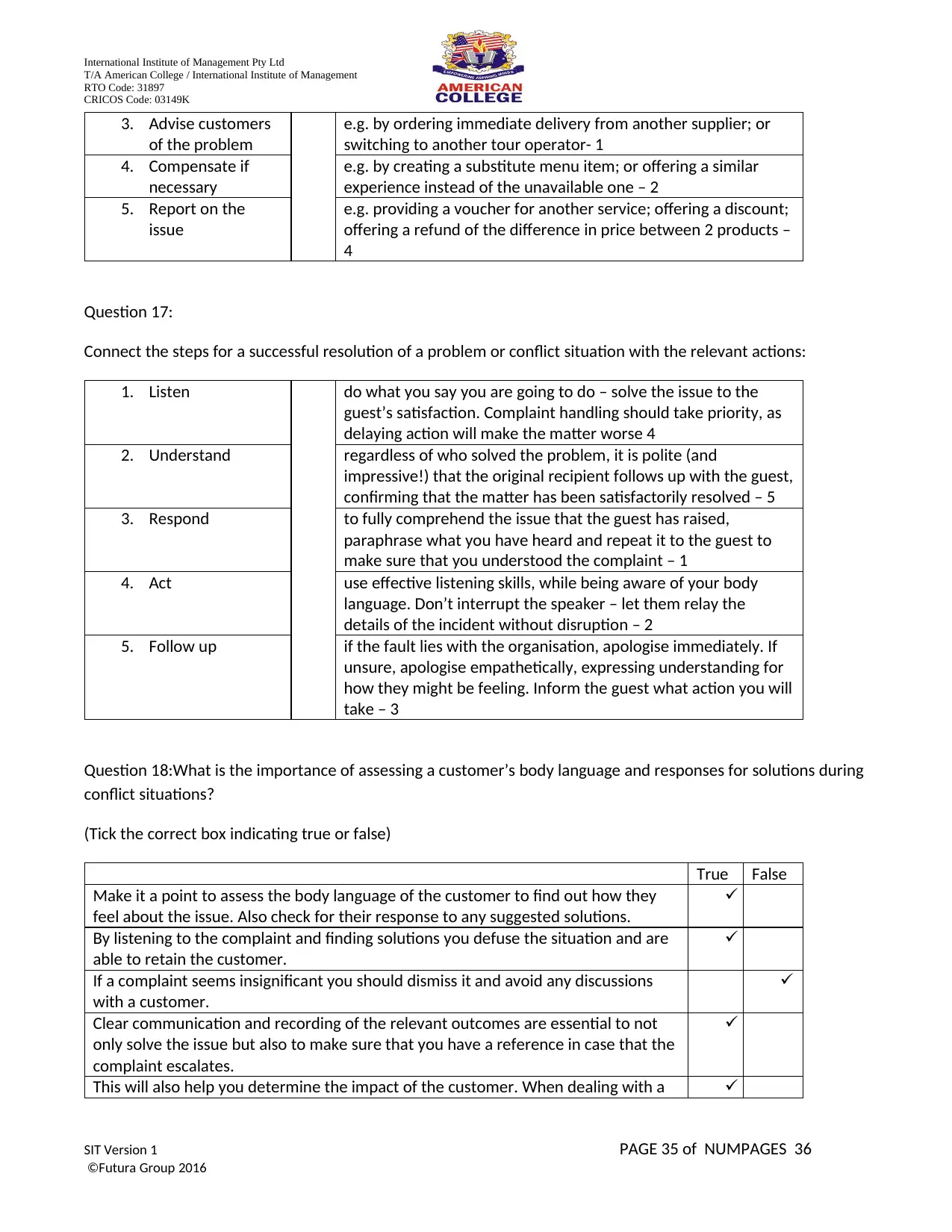
T/A American College / International Institute of Management
RTO Code: 31897
CRICOS Code: 03149K
3. Advise customers
of the problem
e.g. by ordering immediate delivery from another supplier; or
switching to another tour operator- 1
4. Compensate if
necessary
e.g. by creating a substitute menu item; or offering a similar
experience instead of the unavailable one – 2
5. Report on the
issue
e.g. providing a voucher for another service; offering a discount;
offering a refund of the difference in price between 2 products –
4
Question 17:
Connect the steps for a successful resolution of a problem or conflict situation with the relevant actions:
1. Listen do what you say you are going to do – solve the issue to the
guest’s satisfaction. Complaint handling should take priority, as
delaying action will make the matter worse 4
2. Understand regardless of who solved the problem, it is polite (and
impressive!) that the original recipient follows up with the guest,
confirming that the matter has been satisfactorily resolved – 5
3. Respond to fully comprehend the issue that the guest has raised,
paraphrase what you have heard and repeat it to the guest to
make sure that you understood the complaint – 1
4. Act use effective listening skills, while being aware of your body
language. Don’t interrupt the speaker – let them relay the
details of the incident without disruption – 2
5. Follow up if the fault lies with the organisation, apologise immediately. If
unsure, apologise empathetically, expressing understanding for
how they might be feeling. Inform the guest what action you will
take – 3
Question 18:What is the importance of assessing a customer’s body language and responses for solutions during
conflict situations?
(Tick the correct box indicating true or false)
True False
Make it a point to assess the body language of the customer to find out how they
feel about the issue. Also check for their response to any suggested solutions.
By listening to the complaint and finding solutions you defuse the situation and are
able to retain the customer.
If a complaint seems insignificant you should dismiss it and avoid any discussions
with a customer.
Clear communication and recording of the relevant outcomes are essential to not
only solve the issue but also to make sure that you have a reference in case that the
complaint escalates.
This will also help you determine the impact of the customer. When dealing with a
SIT Version 1 PAGE 35 of NUMPAGES 36
©Futura Group 2016

T/A American College / International Institute of Management
RTO Code: 31897
CRICOS Code: 03149K
complaint it is important to not just consider how loud the customer is complaining!
Question 19:Which organizational constraints and policies do you need to consider when dealing with a
complaint?
(Answer true or false in space provided)
True or False
Most businesses establish guidelines for handling complaints. True
Receiving a complaint is not a problem in itself; rather it should be seen as an
opportunity for quality improvement.
True
These guidelines outline appropriate responses and policies, as well as the correct
personnel to deal with the different types of complaints.
True
If a complaint escalates, you should avoid involving management as the customer
may make unreasonable demands.
False
Before offering compensation as a result of a justified complaint it is essential to
consider budgetary constraints and profit margins within the organisation.
True
If an incident escalates find out what the processes are so you are prepared next
time.
True
Part of building a relationship with a customer is ensuring that you use appropriate
complaint handling techniques and reach a win-win situation for all parties.
true
Question 20:Creating a database containing as much data on your customers as possible is an excellent way of
tailoring your service to individuals. Typical data collected would include:
(Tick the correct answers)
Customers’ names, preferences, special requirements and details of products and
services that have been purchased.
Customer feedback and comments.
Customers’ credit card number and credit rating.
Special dietary requirements.
Question 21:The benefits of a customer database to a Tourism, Hospitality and Events business could include:
(Answer true or false in space provided)
True or False
Recognising customers who are loyal and who are profitable to the business. True
Identifying purchasing trends which will assist in developing future marketing plans
and promotional material.
True
Informing existing customers of new products and special deals. True
Adjusting prices according to high levels of demand to enhance business True
SIT Version 1 PAGE 35 of NUMPAGES 36
©Futura Group 2016
⊘ This is a preview!⊘
Do you want full access?
Subscribe today to unlock all pages.

Trusted by 1+ million students worldwide
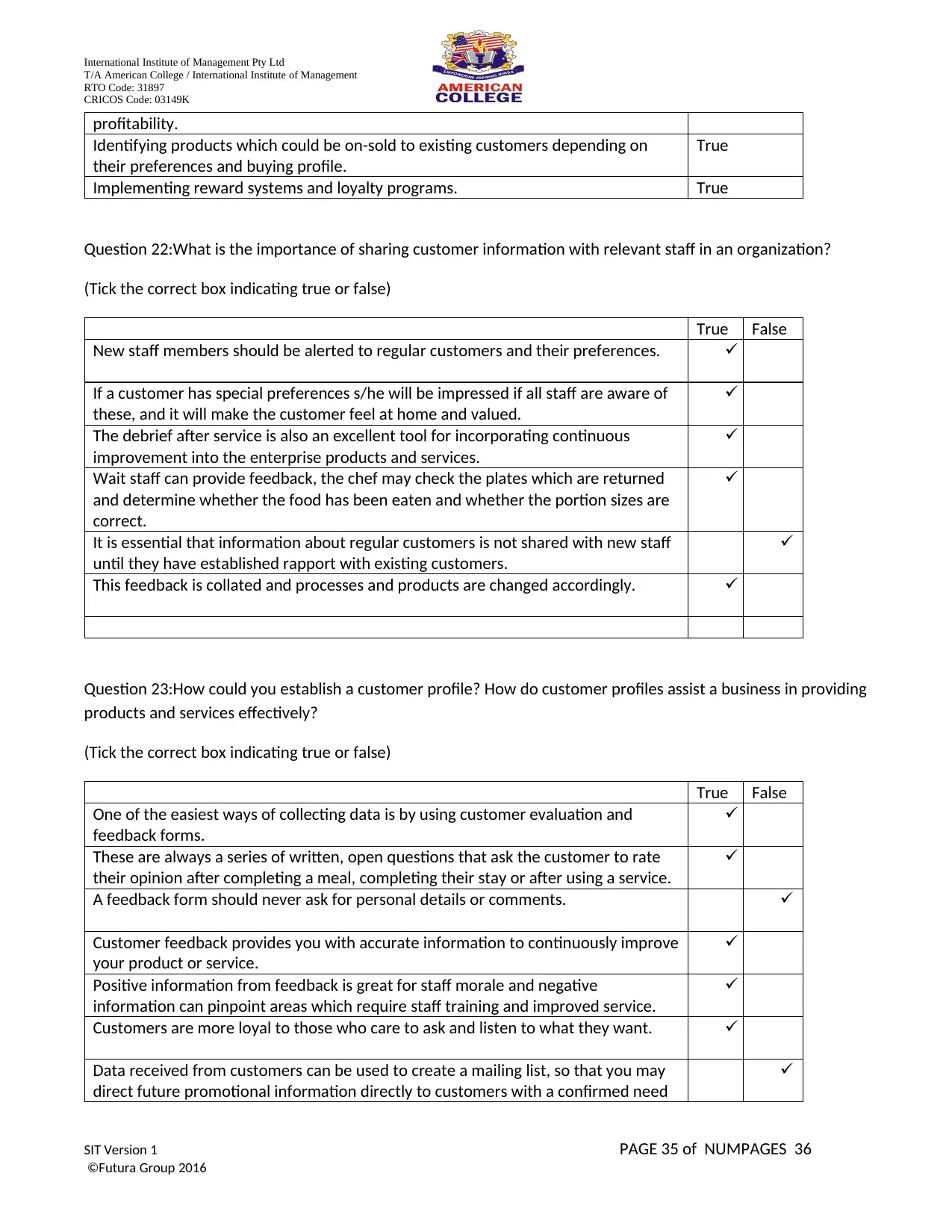
T/A American College / International Institute of Management
RTO Code: 31897
CRICOS Code: 03149K
profitability.
Identifying products which could be on-sold to existing customers depending on
their preferences and buying profile.
True
Implementing reward systems and loyalty programs. True
Question 22:What is the importance of sharing customer information with relevant staff in an organization?
(Tick the correct box indicating true or false)
True False
New staff members should be alerted to regular customers and their preferences.
If a customer has special preferences s/he will be impressed if all staff are aware of
these, and it will make the customer feel at home and valued.
The debrief after service is also an excellent tool for incorporating continuous
improvement into the enterprise products and services.
Wait staff can provide feedback, the chef may check the plates which are returned
and determine whether the food has been eaten and whether the portion sizes are
correct.
It is essential that information about regular customers is not shared with new staff
until they have established rapport with existing customers.
This feedback is collated and processes and products are changed accordingly.
Question 23:How could you establish a customer profile? How do customer profiles assist a business in providing
products and services effectively?
(Tick the correct box indicating true or false)
True False
One of the easiest ways of collecting data is by using customer evaluation and
feedback forms.
These are always a series of written, open questions that ask the customer to rate
their opinion after completing a meal, completing their stay or after using a service.
A feedback form should never ask for personal details or comments.
Customer feedback provides you with accurate information to continuously improve
your product or service.
Positive information from feedback is great for staff morale and negative
information can pinpoint areas which require staff training and improved service.
Customers are more loyal to those who care to ask and listen to what they want.
Data received from customers can be used to create a mailing list, so that you may
direct future promotional information directly to customers with a confirmed need
SIT Version 1 PAGE 35 of NUMPAGES 36
©Futura Group 2016
Paraphrase This Document
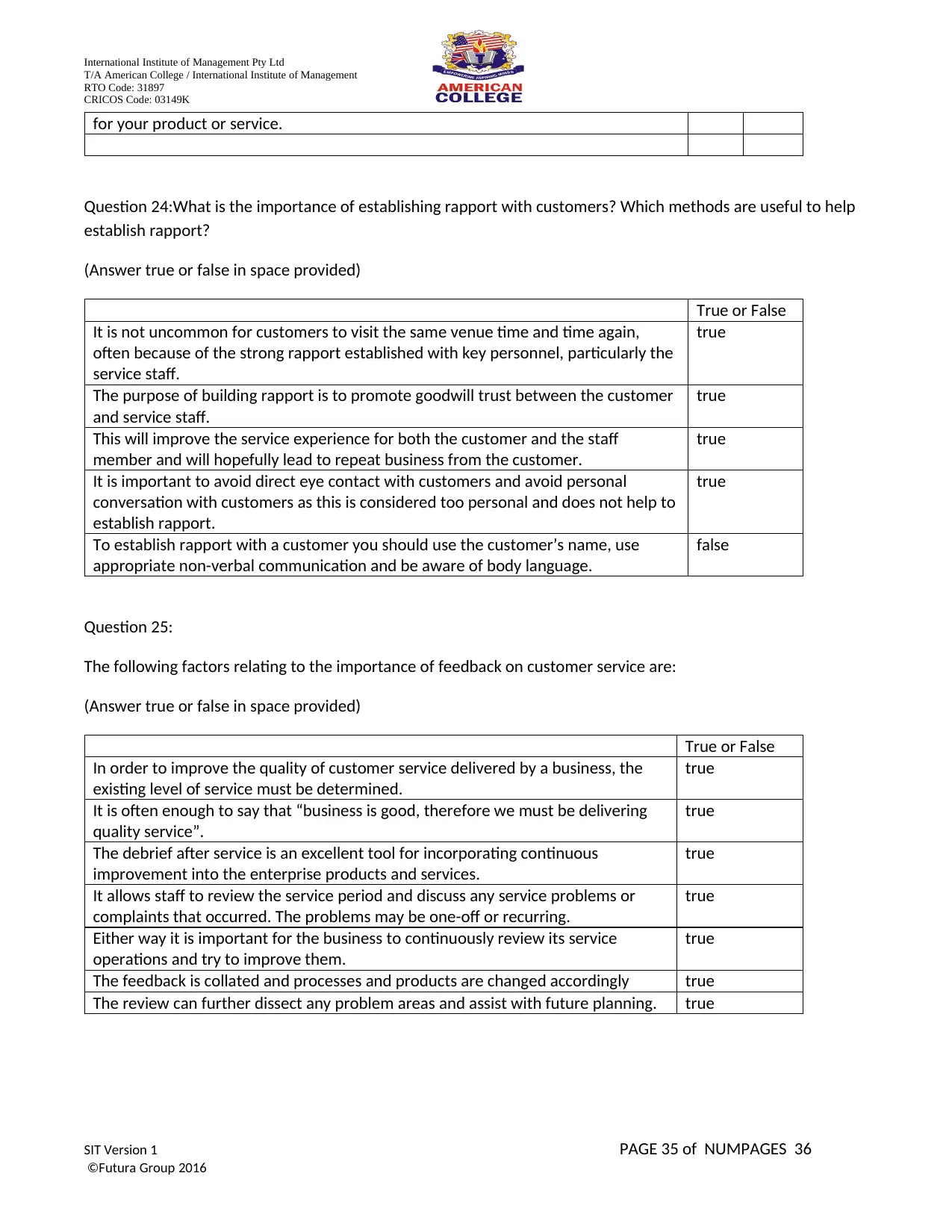
T/A American College / International Institute of Management
RTO Code: 31897
CRICOS Code: 03149K
for your product or service.
Question 24:What is the importance of establishing rapport with customers? Which methods are useful to help
establish rapport?
(Answer true or false in space provided)
True or False
It is not uncommon for customers to visit the same venue time and time again,
often because of the strong rapport established with key personnel, particularly the
service staff.
true
The purpose of building rapport is to promote goodwill trust between the customer
and service staff.
true
This will improve the service experience for both the customer and the staff
member and will hopefully lead to repeat business from the customer.
true
It is important to avoid direct eye contact with customers and avoid personal
conversation with customers as this is considered too personal and does not help to
establish rapport.
true
To establish rapport with a customer you should use the customer’s name, use
appropriate non-verbal communication and be aware of body language.
false
Question 25:
The following factors relating to the importance of feedback on customer service are:
(Answer true or false in space provided)
True or False
In order to improve the quality of customer service delivered by a business, the
existing level of service must be determined.
true
It is often enough to say that “business is good, therefore we must be delivering
quality service”.
true
The debrief after service is an excellent tool for incorporating continuous
improvement into the enterprise products and services.
true
It allows staff to review the service period and discuss any service problems or
complaints that occurred. The problems may be one-off or recurring.
true
Either way it is important for the business to continuously review its service
operations and try to improve them.
true
The feedback is collated and processes and products are changed accordingly true
The review can further dissect any problem areas and assist with future planning. true
SIT Version 1 PAGE 35 of NUMPAGES 36
©Futura Group 2016
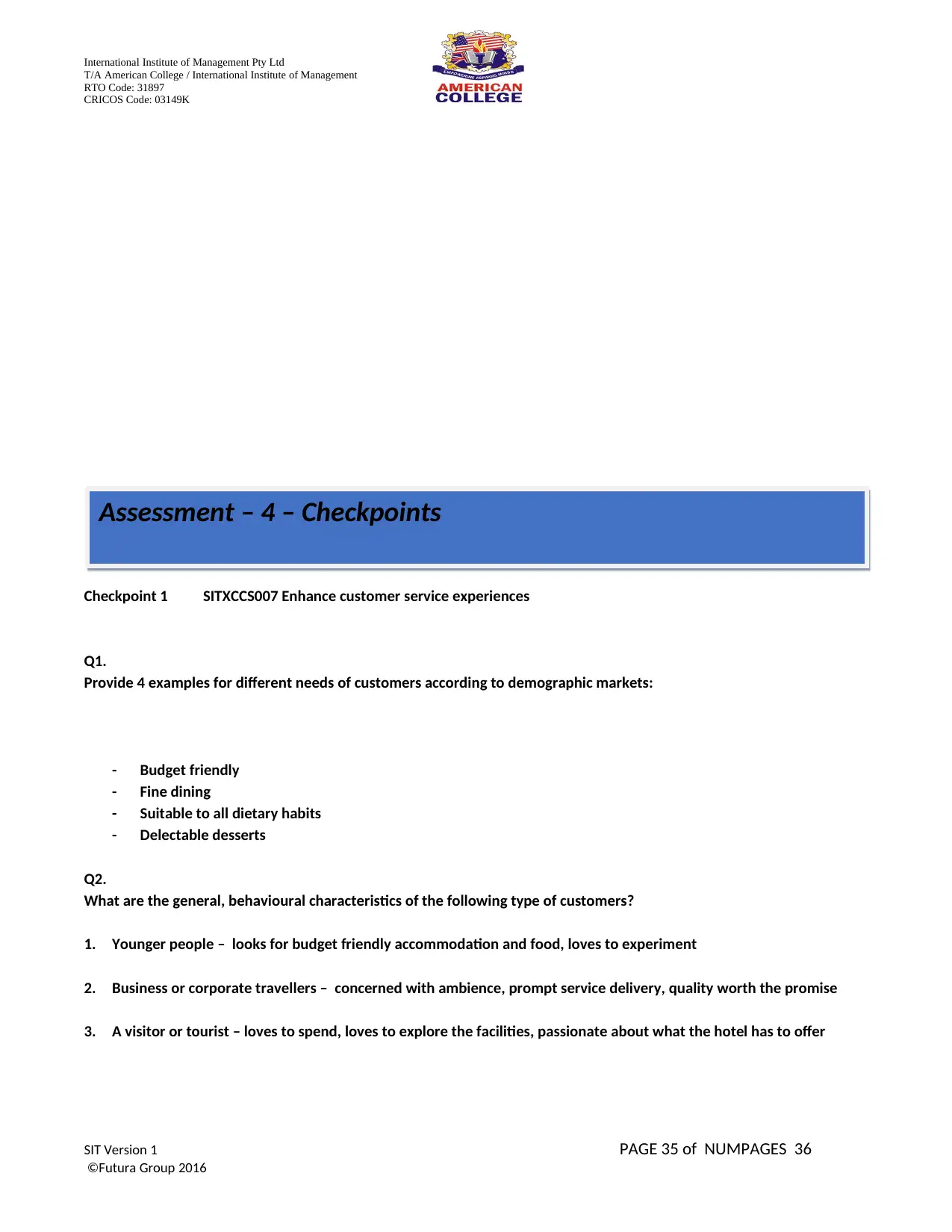
T/A American College / International Institute of Management
RTO Code: 31897
CRICOS Code: 03149K
Checkpoint 1 SITXCCS007 Enhance customer service experiences
Q1.
Provide 4 examples for different needs of customers according to demographic markets:
- Budget friendly
- Fine dining
- Suitable to all dietary habits
- Delectable desserts
Q2.
What are the general, behavioural characteristics of the following type of customers?
1. Younger people – looks for budget friendly accommodation and food, loves to experiment
2. Business or corporate travellers – concerned with ambience, prompt service delivery, quality worth the promise
3. A visitor or tourist – loves to spend, loves to explore the facilities, passionate about what the hotel has to offer
SIT Version 1 PAGE 35 of NUMPAGES 36
©Futura Group 2016
Assessment – 4 – Checkpoints
⊘ This is a preview!⊘
Do you want full access?
Subscribe today to unlock all pages.

Trusted by 1+ million students worldwide
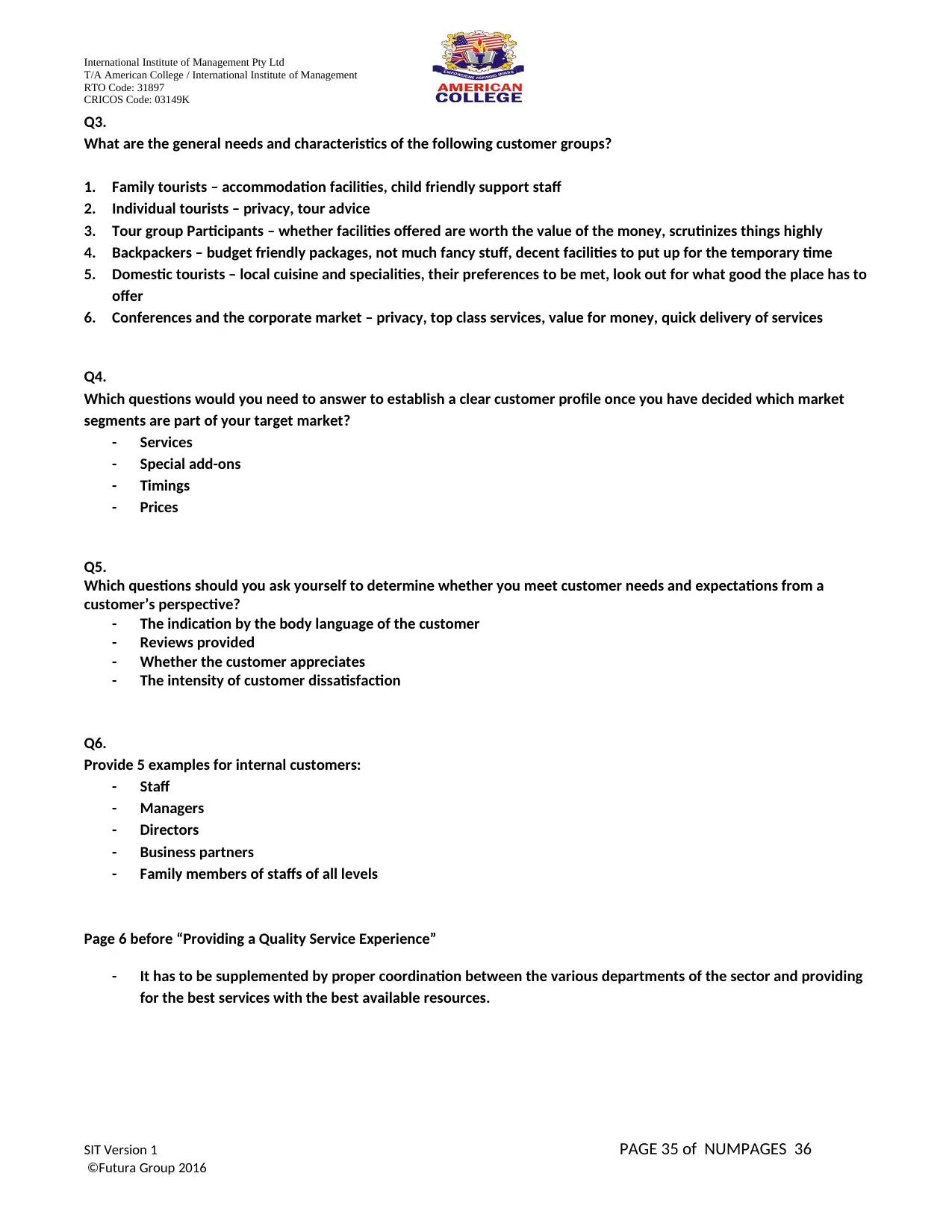
T/A American College / International Institute of Management
RTO Code: 31897
CRICOS Code: 03149K
Q3.
What are the general needs and characteristics of the following customer groups?
1. Family tourists – accommodation facilities, child friendly support staff
2. Individual tourists – privacy, tour advice
3. Tour group Participants – whether facilities offered are worth the value of the money, scrutinizes things highly
4. Backpackers – budget friendly packages, not much fancy stuff, decent facilities to put up for the temporary time
5. Domestic tourists – local cuisine and specialities, their preferences to be met, look out for what good the place has to
offer
6. Conferences and the corporate market – privacy, top class services, value for money, quick delivery of services
Q4.
Which questions would you need to answer to establish a clear customer profile once you have decided which market
segments are part of your target market?
- Services
- Special add-ons
- Timings
- Prices
Q5.
Which questions should you ask yourself to determine whether you meet customer needs and expectations from a
customer’s perspective?
- The indication by the body language of the customer
- Reviews provided
- Whether the customer appreciates
- The intensity of customer dissatisfaction
Q6.
Provide 5 examples for internal customers:
- Staff
- Managers
- Directors
- Business partners
- Family members of staffs of all levels
Page 6 before “Providing a Quality Service Experience”
- It has to be supplemented by proper coordination between the various departments of the sector and providing
for the best services with the best available resources.
SIT Version 1 PAGE 35 of NUMPAGES 36
©Futura Group 2016
Paraphrase This Document
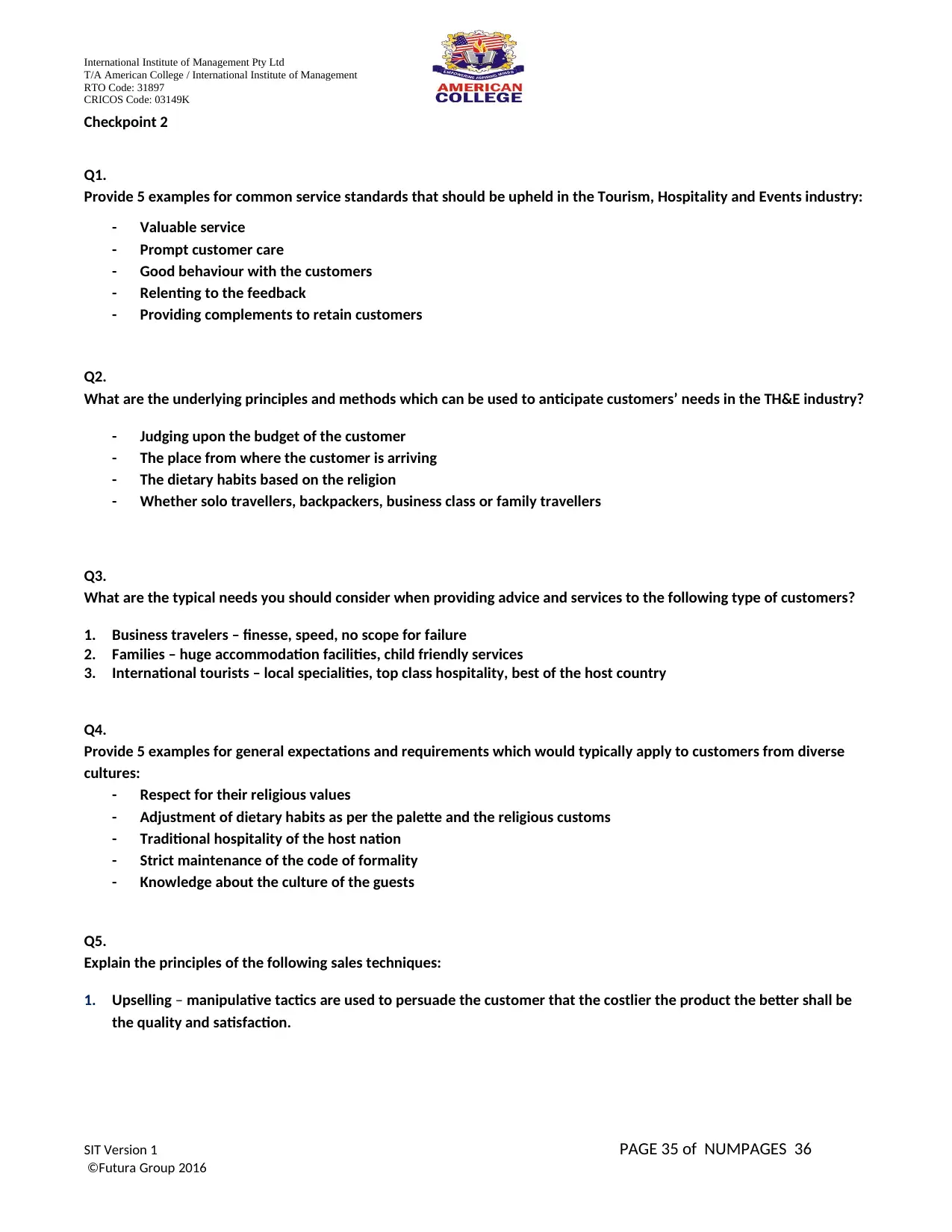
T/A American College / International Institute of Management
RTO Code: 31897
CRICOS Code: 03149K
Checkpoint 2
Q1.
Provide 5 examples for common service standards that should be upheld in the Tourism, Hospitality and Events industry:
- Valuable service
- Prompt customer care
- Good behaviour with the customers
- Relenting to the feedback
- Providing complements to retain customers
Q2.
What are the underlying principles and methods which can be used to anticipate customers’ needs in the TH&E industry?
- Judging upon the budget of the customer
- The place from where the customer is arriving
- The dietary habits based on the religion
- Whether solo travellers, backpackers, business class or family travellers
Q3.
What are the typical needs you should consider when providing advice and services to the following type of customers?
1. Business travelers – finesse, speed, no scope for failure
2. Families – huge accommodation facilities, child friendly services
3. International tourists – local specialities, top class hospitality, best of the host country
Q4.
Provide 5 examples for general expectations and requirements which would typically apply to customers from diverse
cultures:
- Respect for their religious values
- Adjustment of dietary habits as per the palette and the religious customs
- Traditional hospitality of the host nation
- Strict maintenance of the code of formality
- Knowledge about the culture of the guests
Q5.
Explain the principles of the following sales techniques:
1. Upselling – manipulative tactics are used to persuade the customer that the costlier the product the better shall be
the quality and satisfaction.
SIT Version 1 PAGE 35 of NUMPAGES 36
©Futura Group 2016
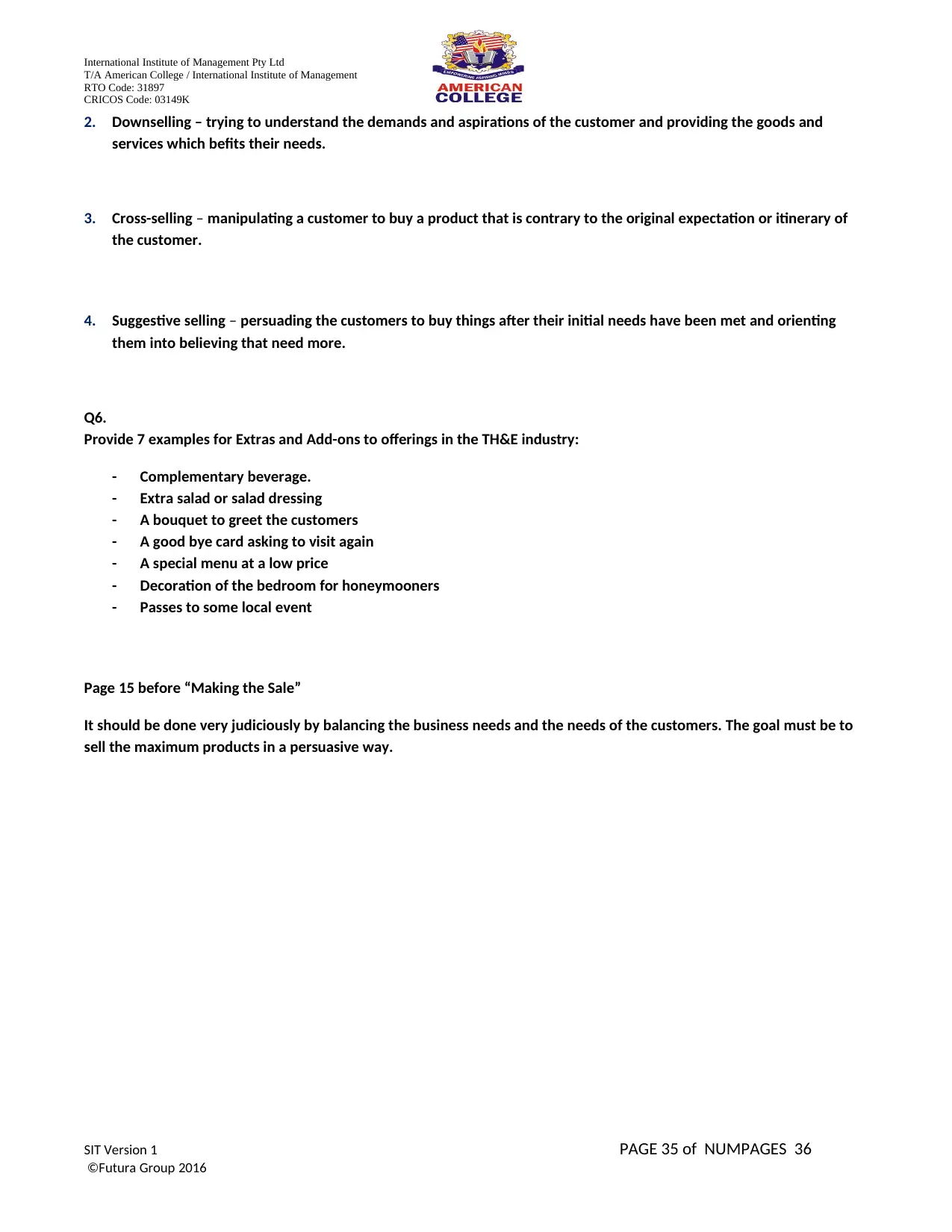
T/A American College / International Institute of Management
RTO Code: 31897
CRICOS Code: 03149K
2. Downselling – trying to understand the demands and aspirations of the customer and providing the goods and
services which befits their needs.
3. Cross-selling – manipulating a customer to buy a product that is contrary to the original expectation or itinerary of
the customer.
4. Suggestive selling – persuading the customers to buy things after their initial needs have been met and orienting
them into believing that need more.
Q6.
Provide 7 examples for Extras and Add-ons to offerings in the TH&E industry:
- Complementary beverage.
- Extra salad or salad dressing
- A bouquet to greet the customers
- A good bye card asking to visit again
- A special menu at a low price
- Decoration of the bedroom for honeymooners
- Passes to some local event
Page 15 before “Making the Sale”
It should be done very judiciously by balancing the business needs and the needs of the customers. The goal must be to
sell the maximum products in a persuasive way.
SIT Version 1 PAGE 35 of NUMPAGES 36
©Futura Group 2016
⊘ This is a preview!⊘
Do you want full access?
Subscribe today to unlock all pages.

Trusted by 1+ million students worldwide
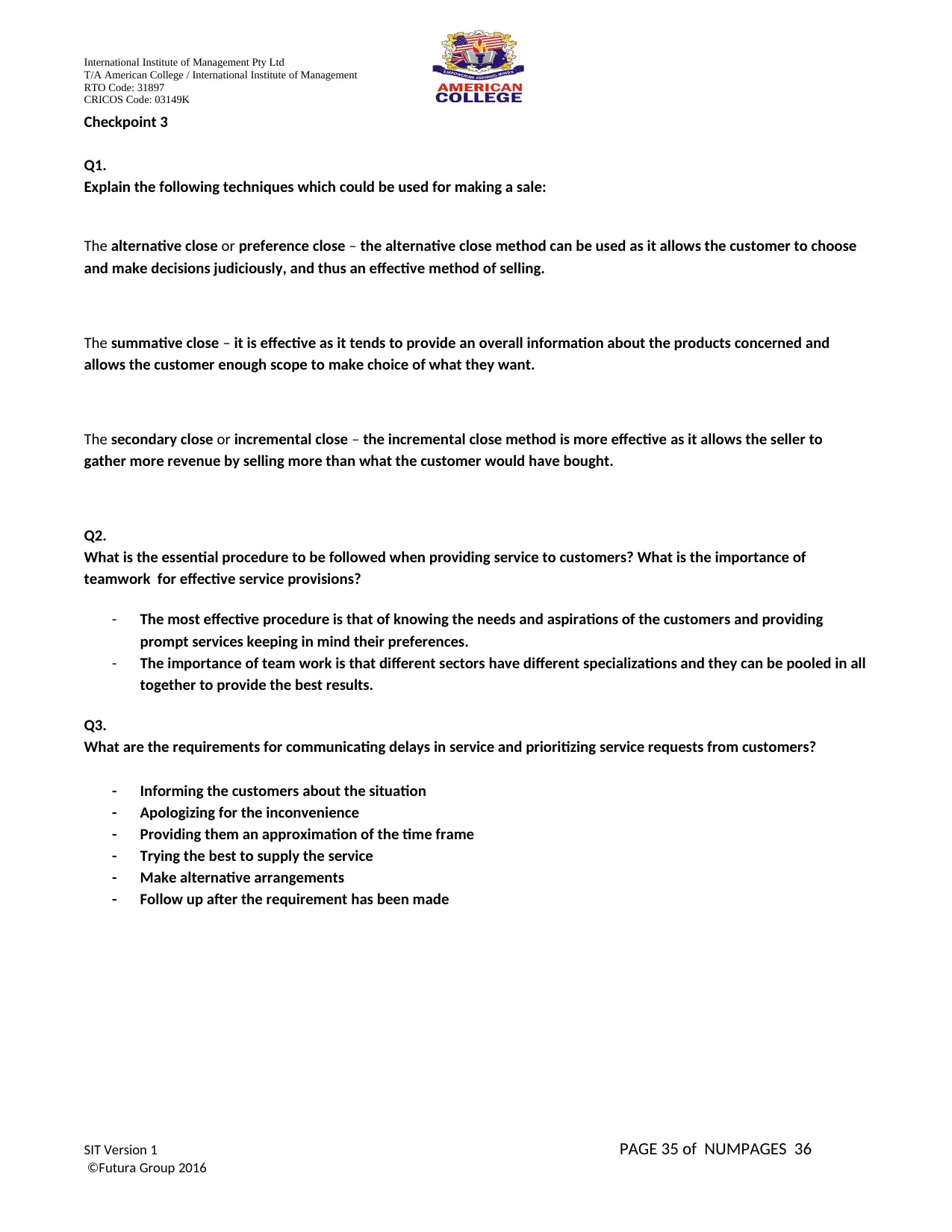
T/A American College / International Institute of Management
RTO Code: 31897
CRICOS Code: 03149K
Checkpoint 3
Q1.
Explain the following techniques which could be used for making a sale:
The alternative close or preference close – the alternative close method can be used as it allows the customer to choose
and make decisions judiciously, and thus an effective method of selling.
The summative close – it is effective as it tends to provide an overall information about the products concerned and
allows the customer enough scope to make choice of what they want.
The secondary close or incremental close – the incremental close method is more effective as it allows the seller to
gather more revenue by selling more than what the customer would have bought.
Q2.
What is the essential procedure to be followed when providing service to customers? What is the importance of
teamwork for effective service provisions?
- The most effective procedure is that of knowing the needs and aspirations of the customers and providing
prompt services keeping in mind their preferences.
- The importance of team work is that different sectors have different specializations and they can be pooled in all
together to provide the best results.
Q3.
What are the requirements for communicating delays in service and prioritizing service requests from customers?
- Informing the customers about the situation
- Apologizing for the inconvenience
- Providing them an approximation of the time frame
- Trying the best to supply the service
- Make alternative arrangements
- Follow up after the requirement has been made
SIT Version 1 PAGE 35 of NUMPAGES 36
©Futura Group 2016
Paraphrase This Document

T/A American College / International Institute of Management
RTO Code: 31897
CRICOS Code: 03149K
Q4.
What is the importance of liaising with colleagues and suppliers to ensure effective customer service provisions?
- They serve as backups and they help in sustaining the needs of the hospitality sector and provides services
which are otherwise not provided by the hotel. Hence they must be liaised with for the sake of ensuring
effective customer service.
Q5.
Sharing information you have gained on your products and market with your colleagues will enhance team effectiveness,
by focussing all staff members on providing the same type and level of service to customers.
List 4 examples of information which should be shared with colleagues.
- The preferences of the customers
- The issues affecting the customers
- The status of payment
- The feedback of the customers
Page 19 before “Preventing Service Issues”
Preventing service issues can be resolved by means of making the necessary planning and by properly communicating
the staff to remain proactive.
SIT Version 1 PAGE 35 of NUMPAGES 36
©Futura Group 2016

T/A American College / International Institute of Management
RTO Code: 31897
CRICOS Code: 03149K
Checkpoint 4
Q1.
Provide 5 proactive steps you should take to prevent and respond to service or quality issues in customer service:
- Listen to the issue patiently
- Apologize
- Follow up
- Make alternative arrangements
- Offer more if possible to make up for the loss
Q2.
Which key aspects should you consider when dealing with unhappy patrons to prevent an escalation?
- Apologize
- Explain them the predicament
- Accept what they have to say
- No argument with them
- Assurance for alternative arrangements
Q3.
List and explain the 5 step procedure which should be followed for a successful resolution of a problem:
- Patient hearing of the issue
- Apologizing immediately
- Making arrangements immediately.
- Following up with assurance that things shall be done in a specific time frame
- Making either alternative arrangements or rectifying the mistake
Q4.
What is the importance of assessing a customer’s body language and responses for solutions during a conflict situation?
- The body language speaks about the level of disgust of the customer
- An indication of the urgency of the issue to be addressed
- Indication of the patience level of the customer
- The degree of seriousness of the fault of the customer
- Indication whether they shall be returning to the facility or not
SIT Version 1 PAGE 35 of NUMPAGES 36
©Futura Group 2016
⊘ This is a preview!⊘
Do you want full access?
Subscribe today to unlock all pages.

Trusted by 1+ million students worldwide
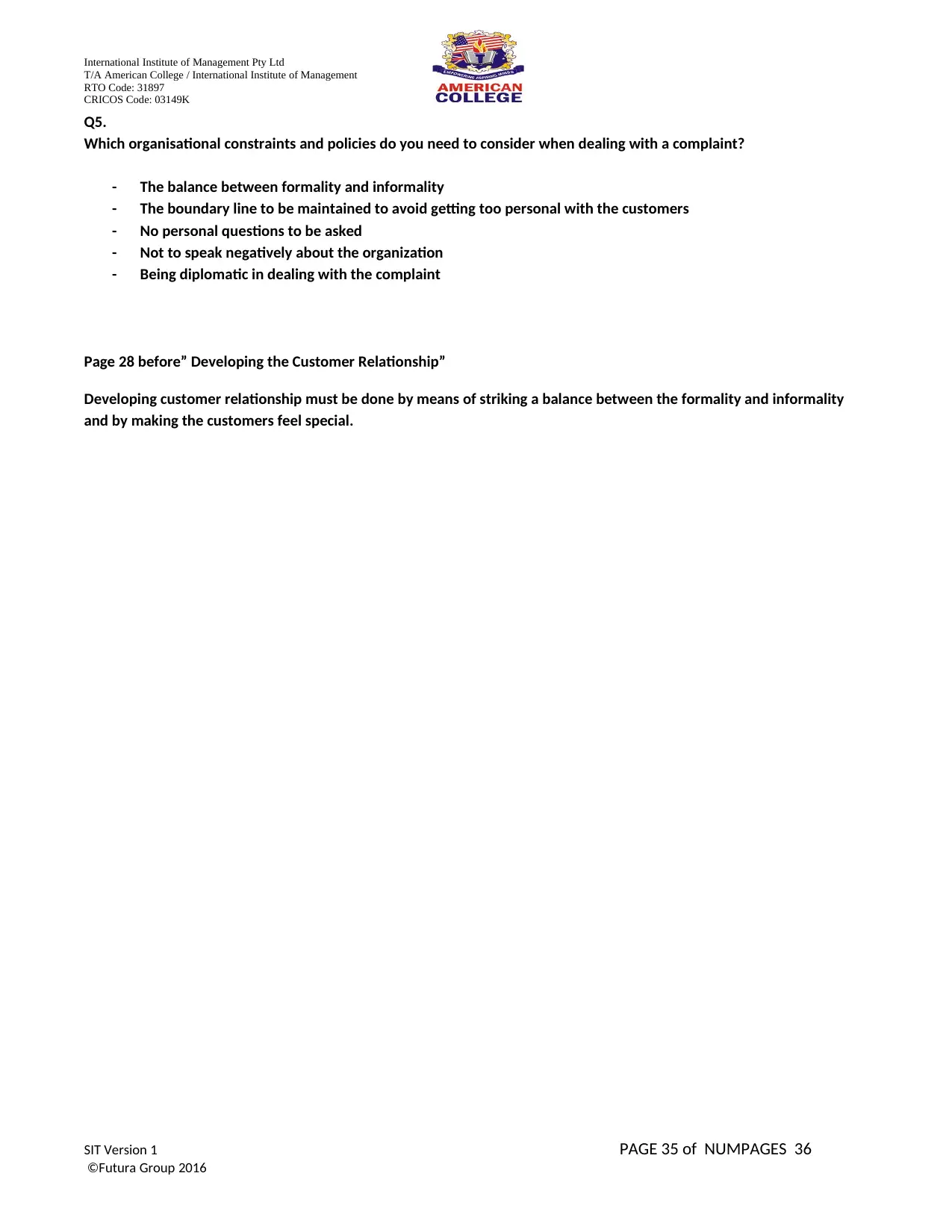
T/A American College / International Institute of Management
RTO Code: 31897
CRICOS Code: 03149K
Q5.
Which organisational constraints and policies do you need to consider when dealing with a complaint?
- The balance between formality and informality
- The boundary line to be maintained to avoid getting too personal with the customers
- No personal questions to be asked
- Not to speak negatively about the organization
- Being diplomatic in dealing with the complaint
Page 28 before” Developing the Customer Relationship”
Developing customer relationship must be done by means of striking a balance between the formality and informality
and by making the customers feel special.
SIT Version 1 PAGE 35 of NUMPAGES 36
©Futura Group 2016
Paraphrase This Document
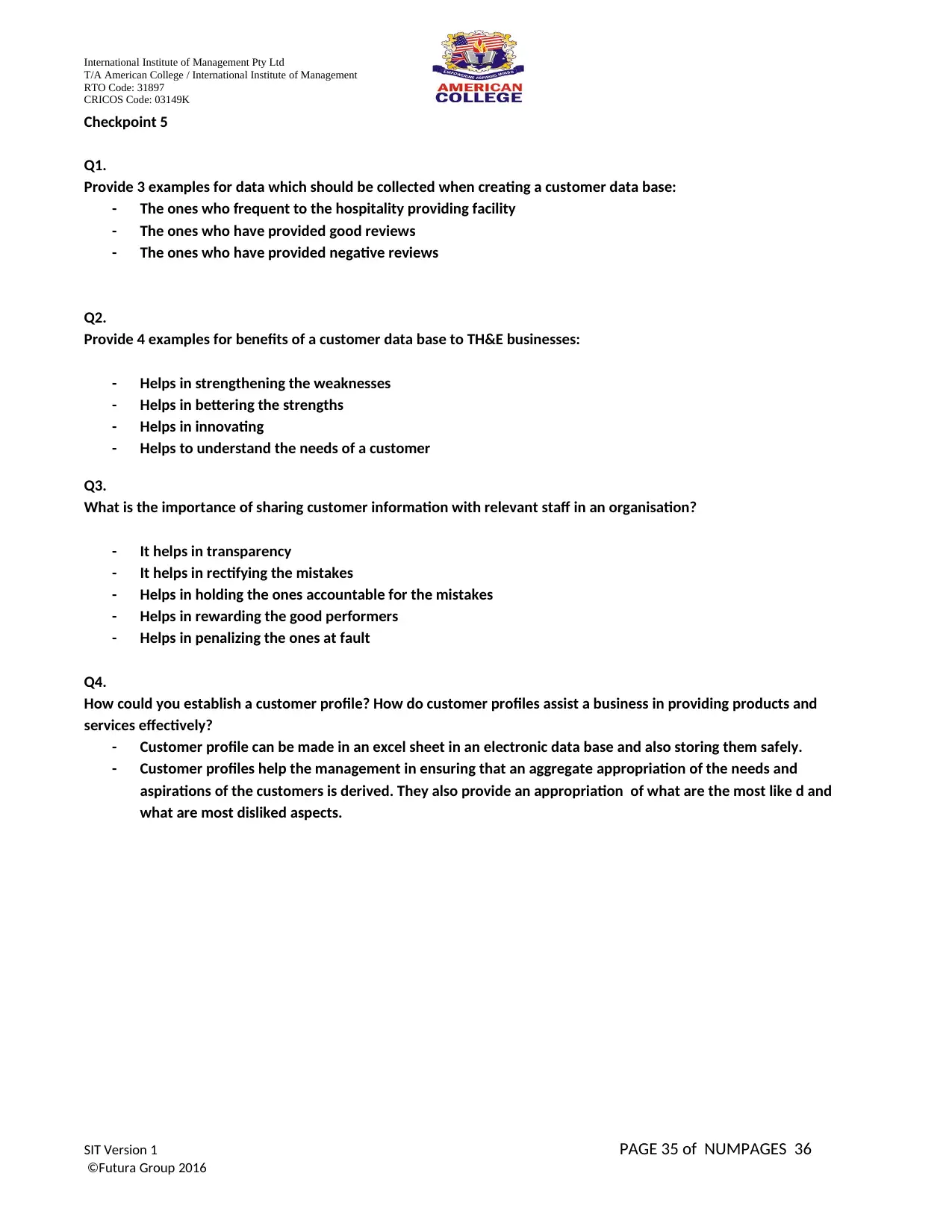
T/A American College / International Institute of Management
RTO Code: 31897
CRICOS Code: 03149K
Checkpoint 5
Q1.
Provide 3 examples for data which should be collected when creating a customer data base:
- The ones who frequent to the hospitality providing facility
- The ones who have provided good reviews
- The ones who have provided negative reviews
Q2.
Provide 4 examples for benefits of a customer data base to TH&E businesses:
- Helps in strengthening the weaknesses
- Helps in bettering the strengths
- Helps in innovating
- Helps to understand the needs of a customer
Q3.
What is the importance of sharing customer information with relevant staff in an organisation?
- It helps in transparency
- It helps in rectifying the mistakes
- Helps in holding the ones accountable for the mistakes
- Helps in rewarding the good performers
- Helps in penalizing the ones at fault
Q4.
How could you establish a customer profile? How do customer profiles assist a business in providing products and
services effectively?
- Customer profile can be made in an excel sheet in an electronic data base and also storing them safely.
- Customer profiles help the management in ensuring that an aggregate appropriation of the needs and
aspirations of the customers is derived. They also provide an appropriation of what are the most like d and
what are most disliked aspects.
SIT Version 1 PAGE 35 of NUMPAGES 36
©Futura Group 2016
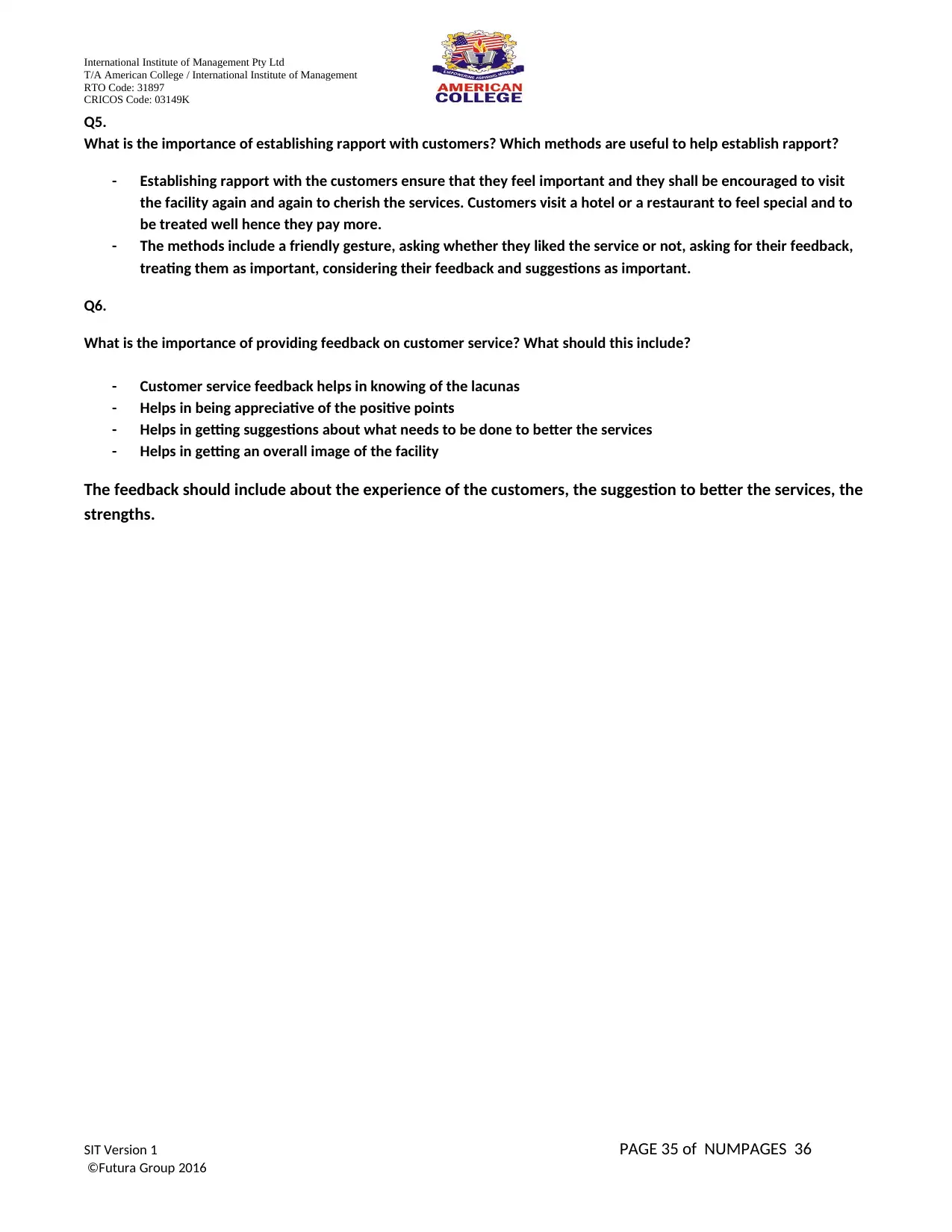
T/A American College / International Institute of Management
RTO Code: 31897
CRICOS Code: 03149K
Q5.
What is the importance of establishing rapport with customers? Which methods are useful to help establish rapport?
- Establishing rapport with the customers ensure that they feel important and they shall be encouraged to visit
the facility again and again to cherish the services. Customers visit a hotel or a restaurant to feel special and to
be treated well hence they pay more.
- The methods include a friendly gesture, asking whether they liked the service or not, asking for their feedback,
treating them as important, considering their feedback and suggestions as important.
Q6.
What is the importance of providing feedback on customer service? What should this include?
- Customer service feedback helps in knowing of the lacunas
- Helps in being appreciative of the positive points
- Helps in getting suggestions about what needs to be done to better the services
- Helps in getting an overall image of the facility
The feedback should include about the experience of the customers, the suggestion to better the services, the
strengths.
SIT Version 1 PAGE 35 of NUMPAGES 36
©Futura Group 2016
⊘ This is a preview!⊘
Do you want full access?
Subscribe today to unlock all pages.

Trusted by 1+ million students worldwide
Related Documents
Your All-in-One AI-Powered Toolkit for Academic Success.
+13062052269
info@desklib.com
Available 24*7 on WhatsApp / Email
![[object Object]](/_next/static/media/star-bottom.7253800d.svg)
© 2024 | Zucol Services PVT LTD | All rights reserved.




